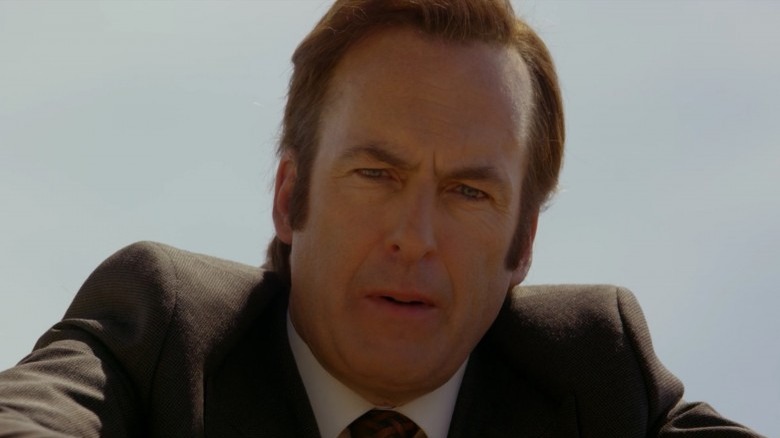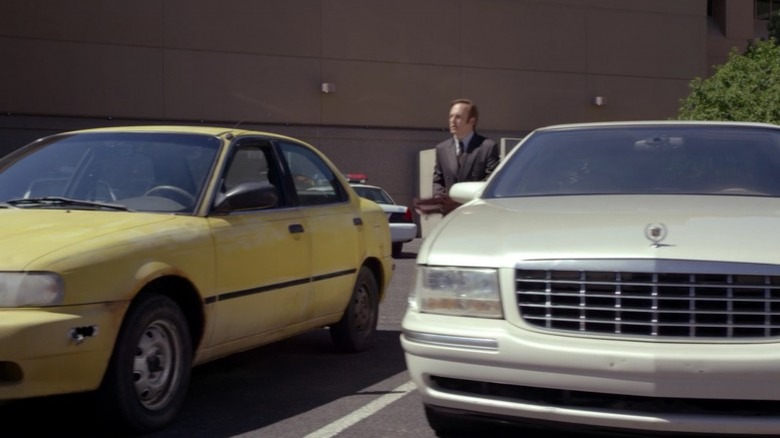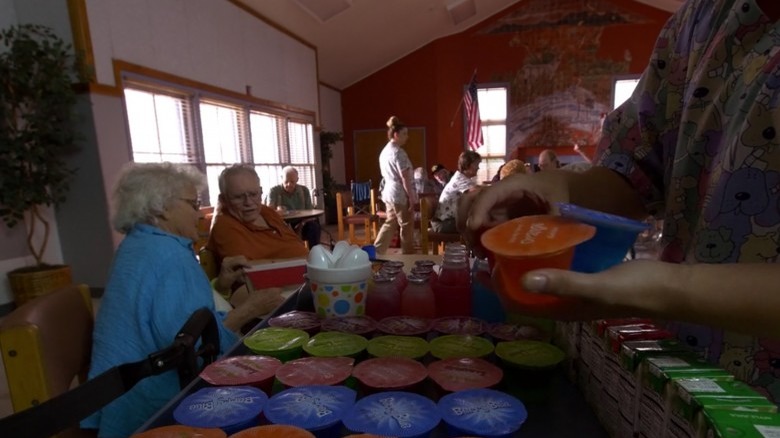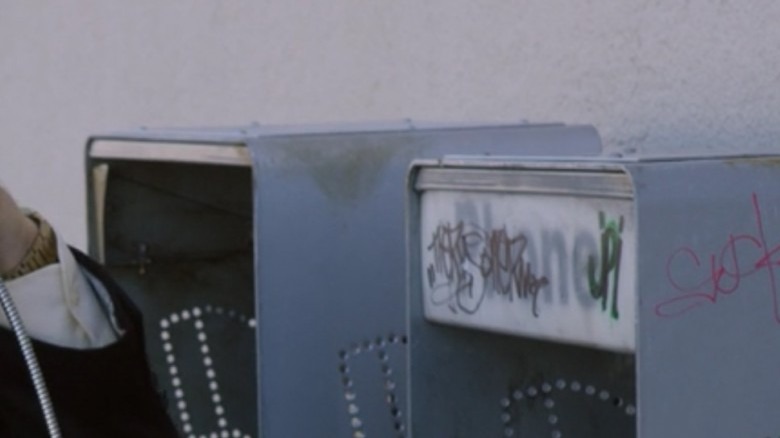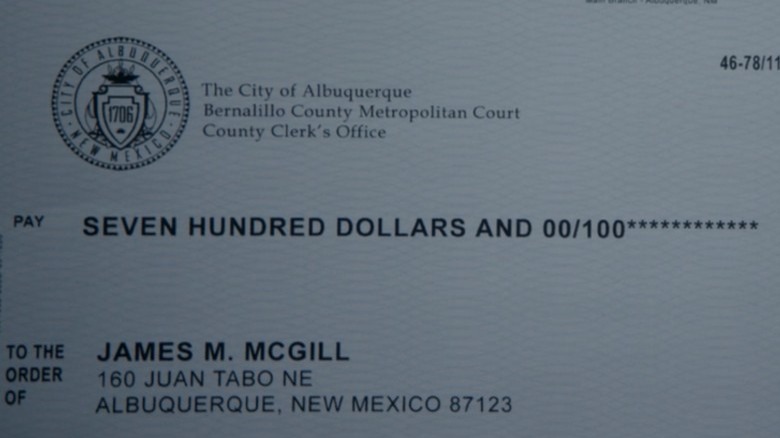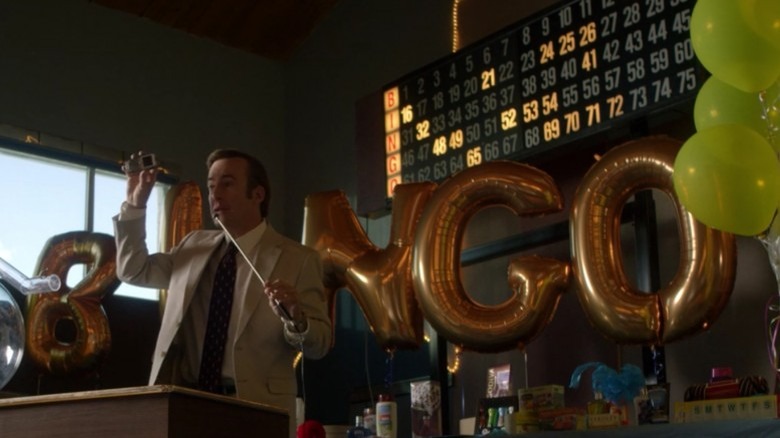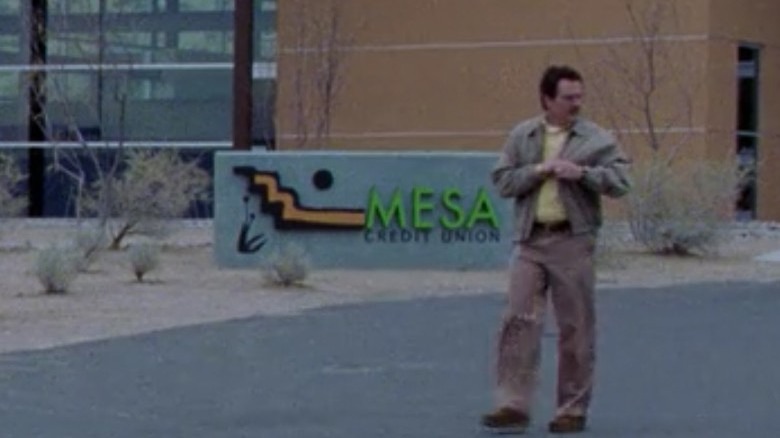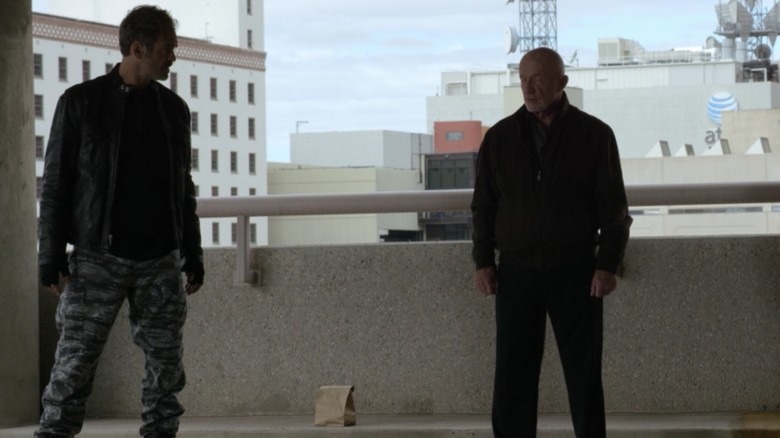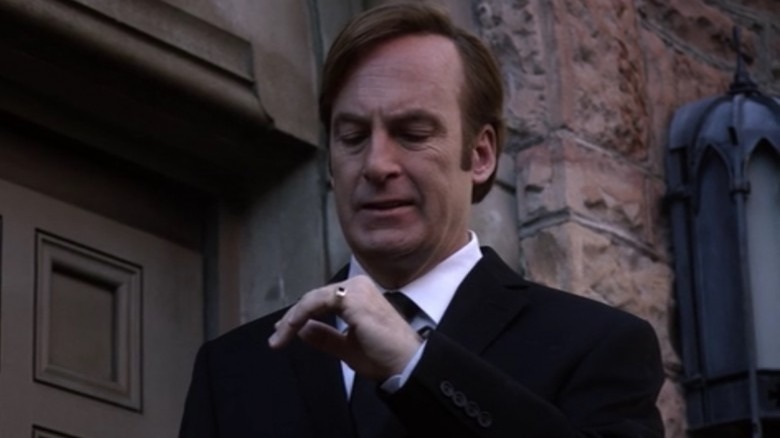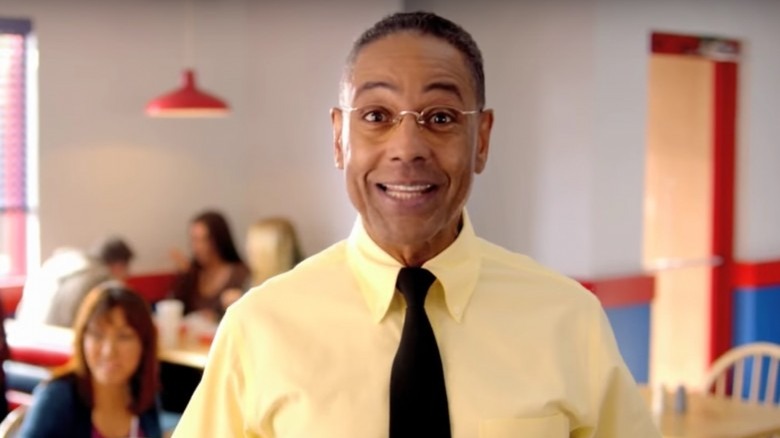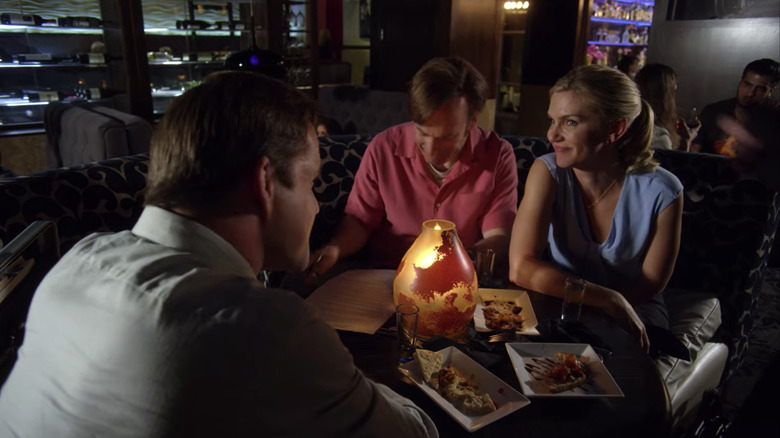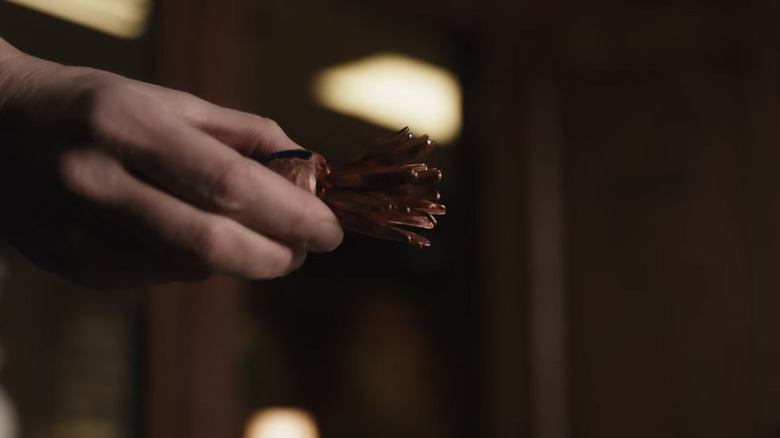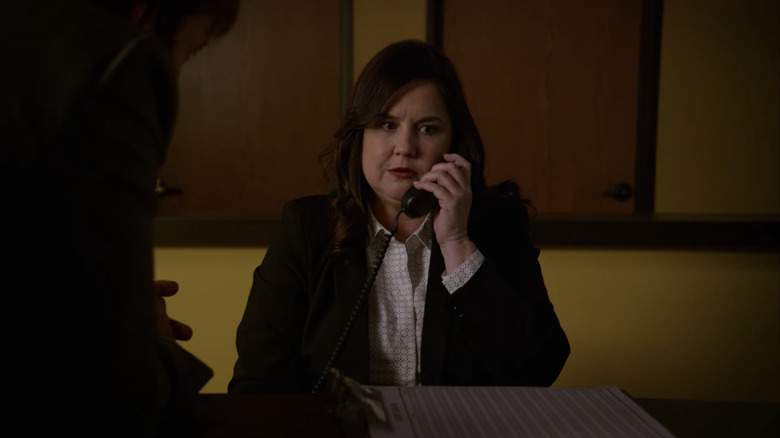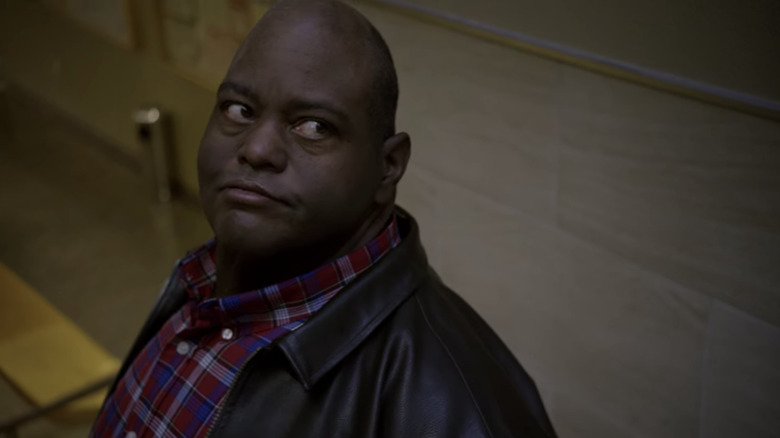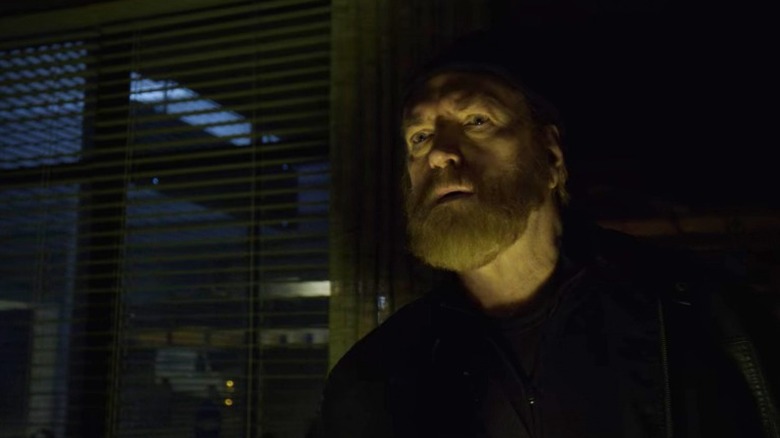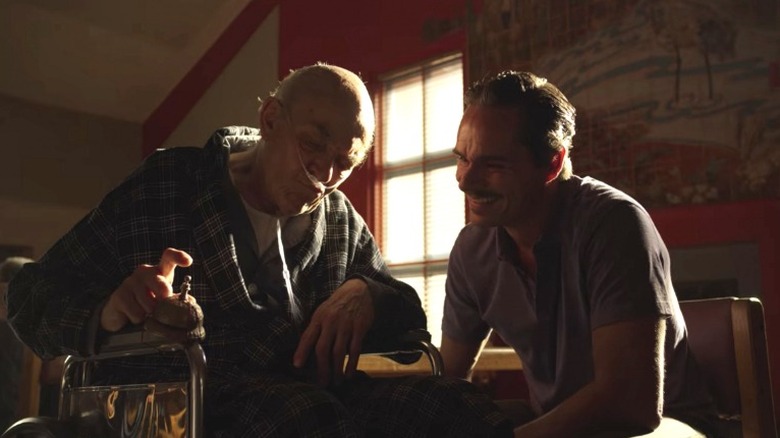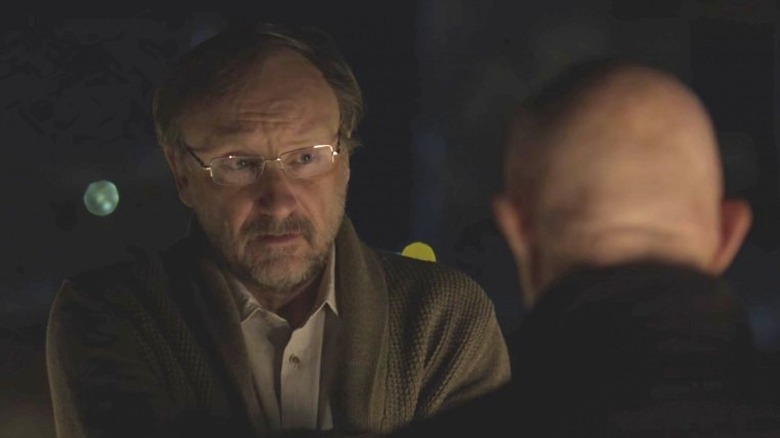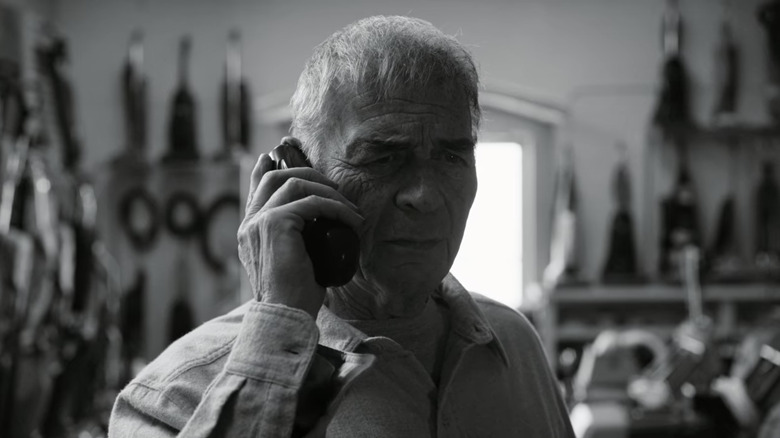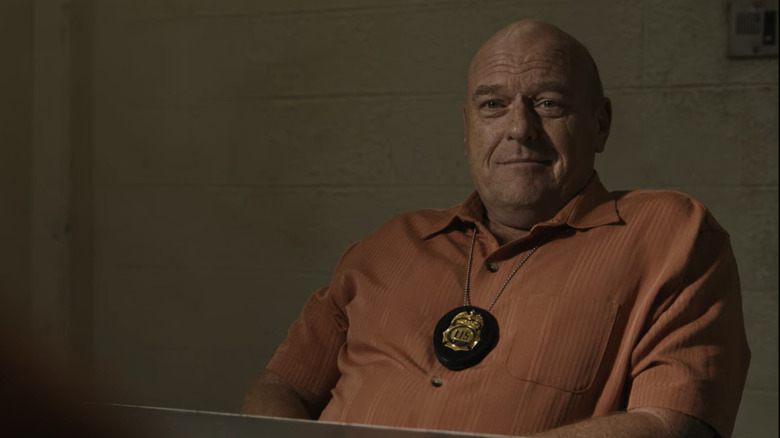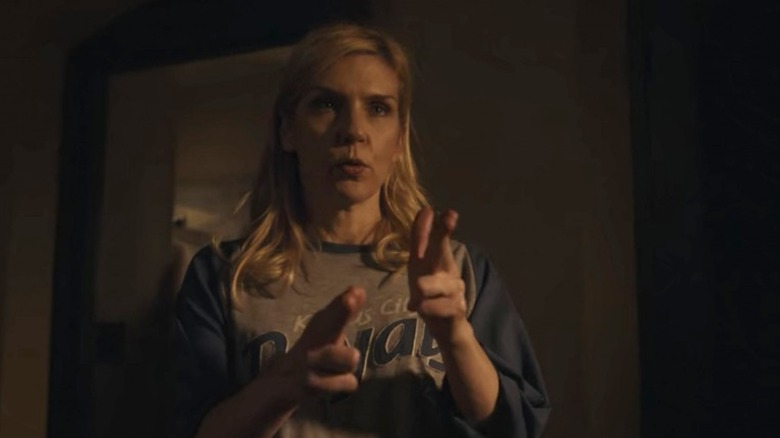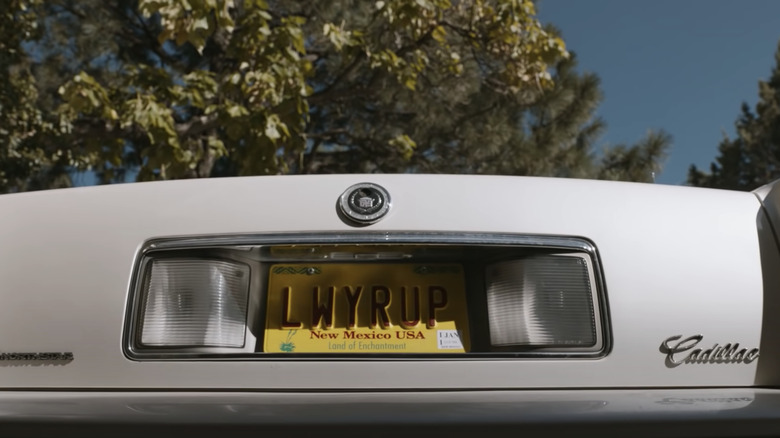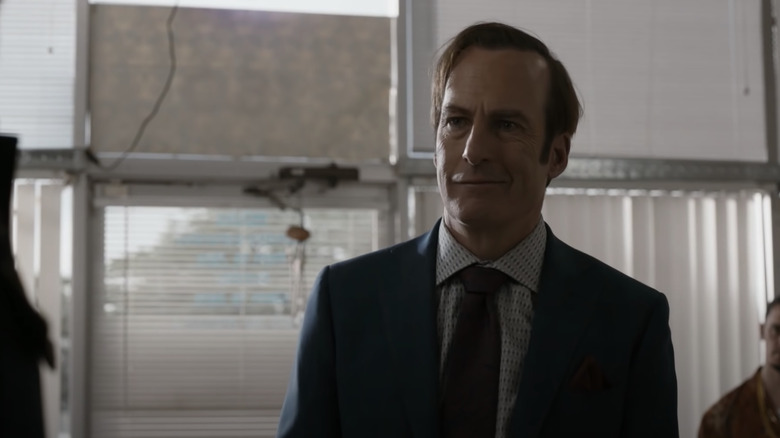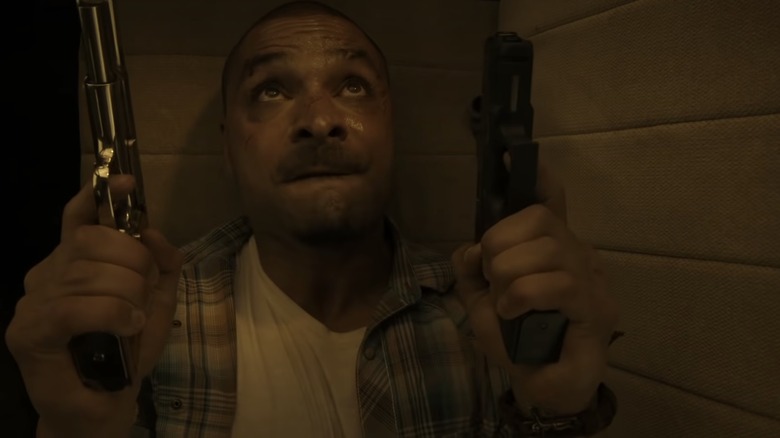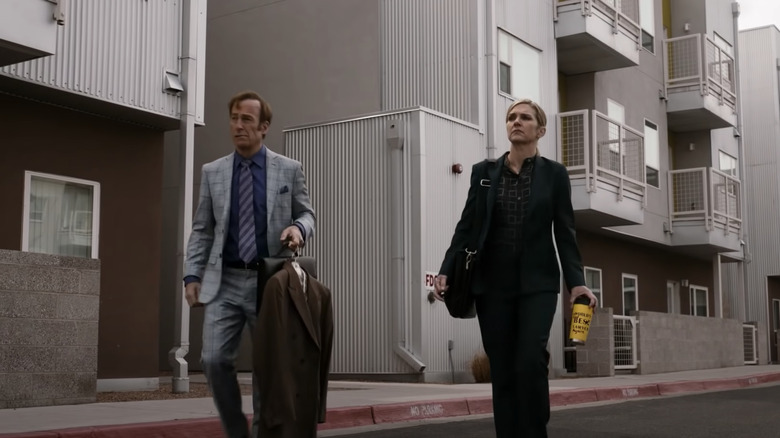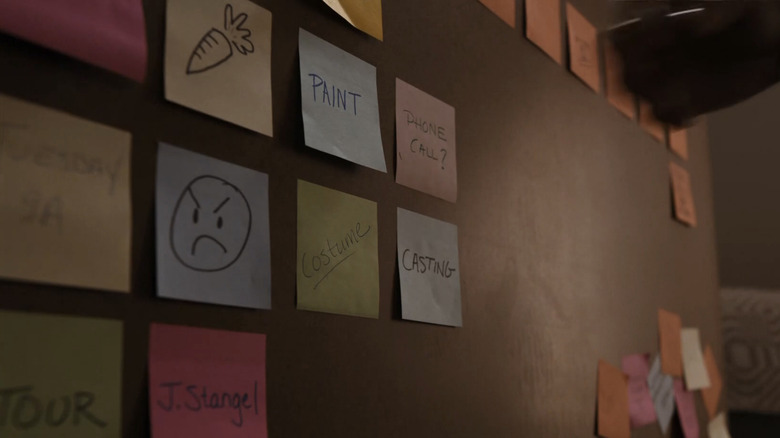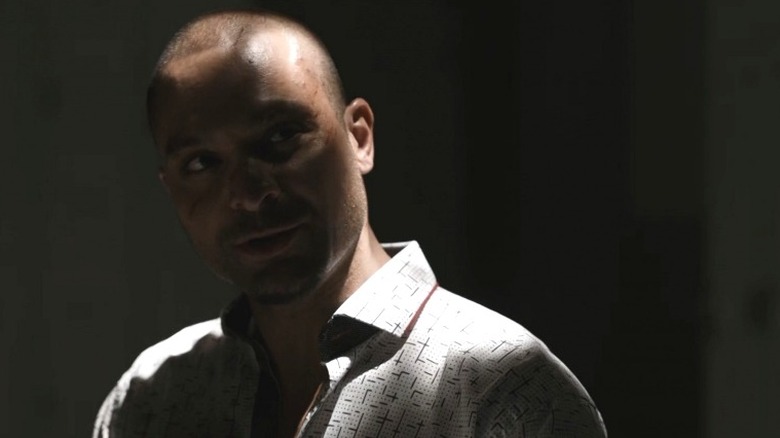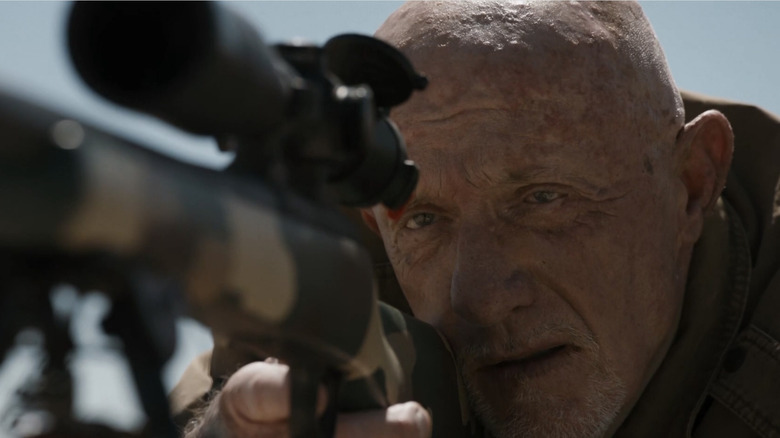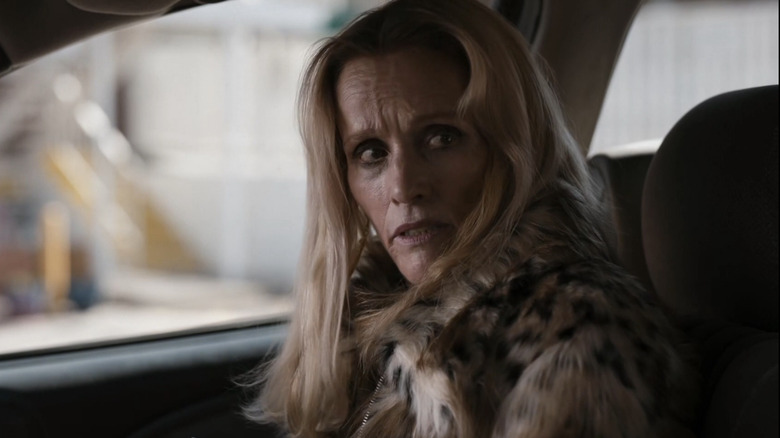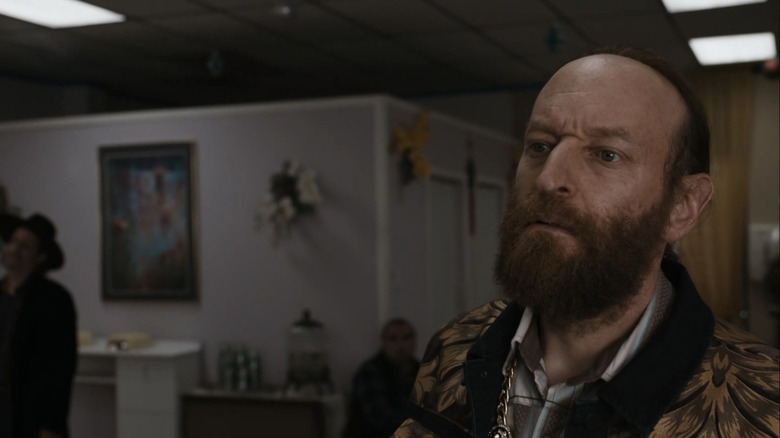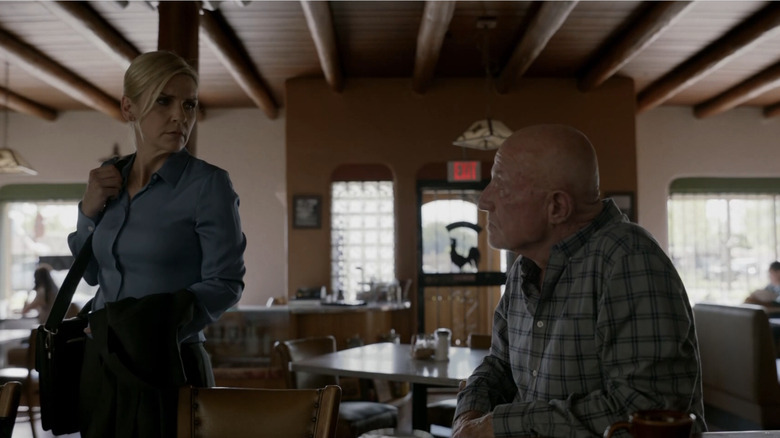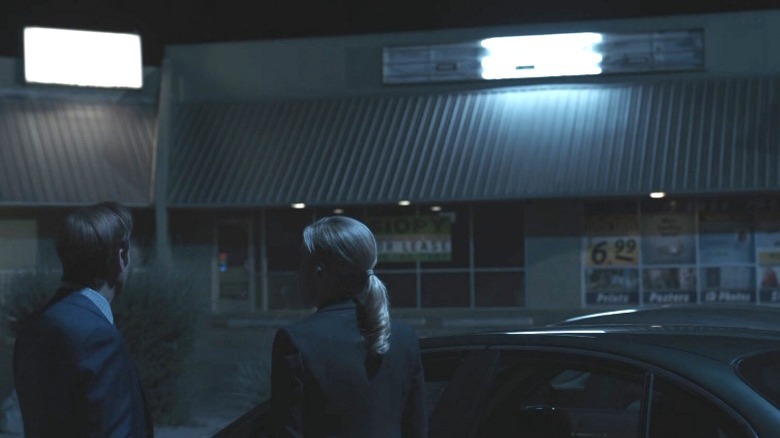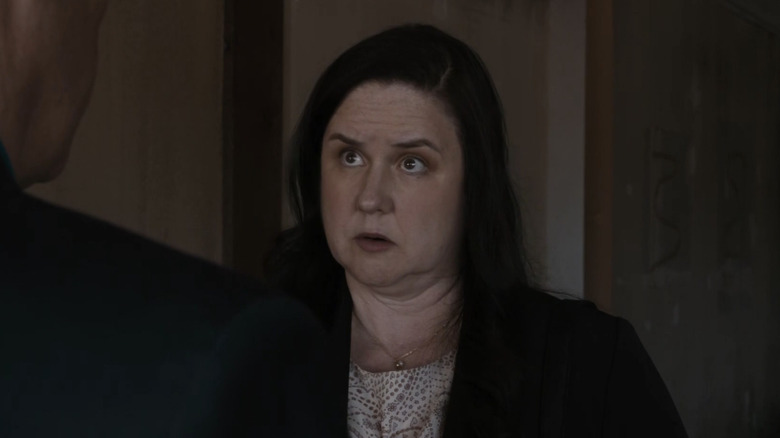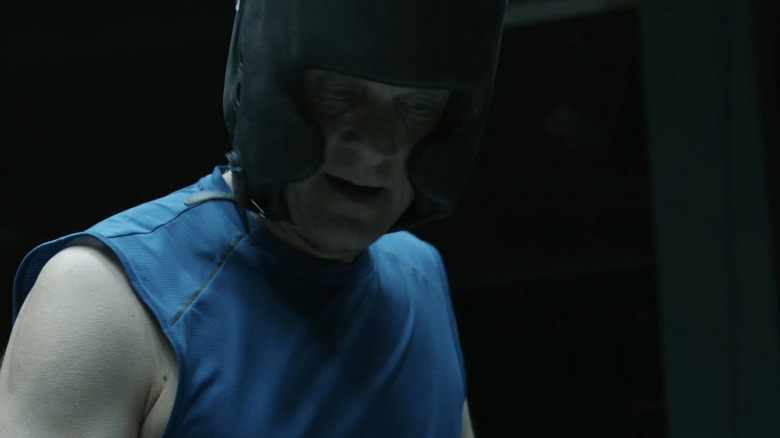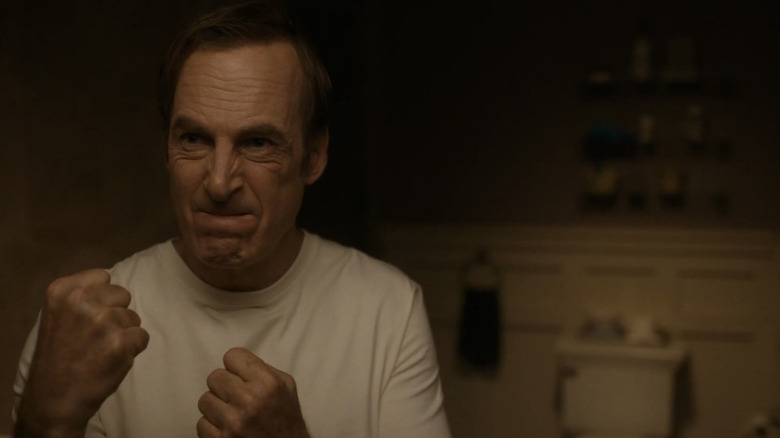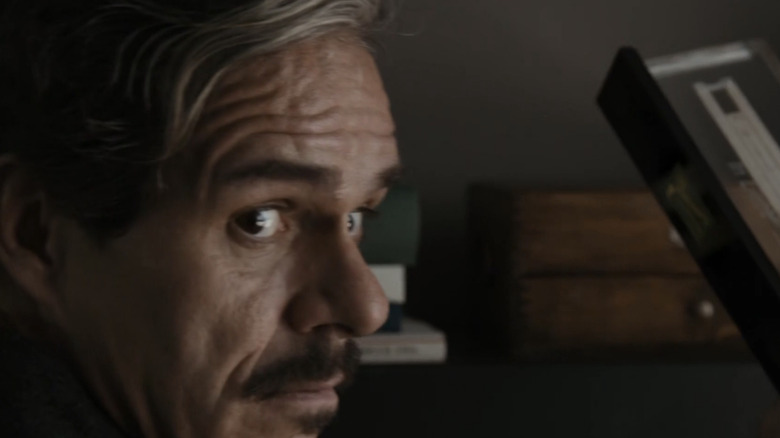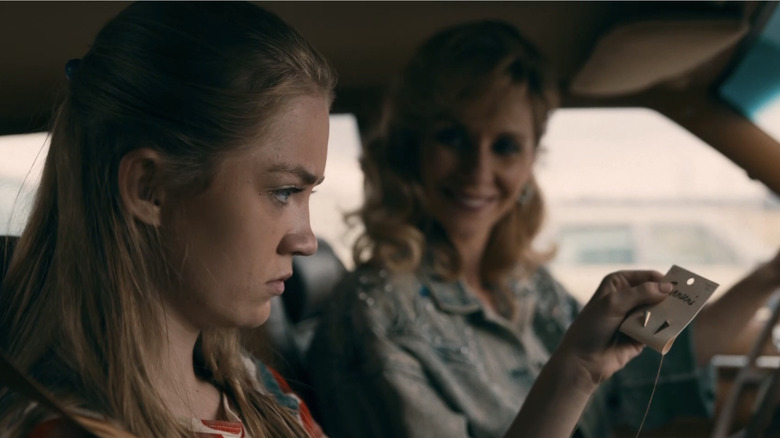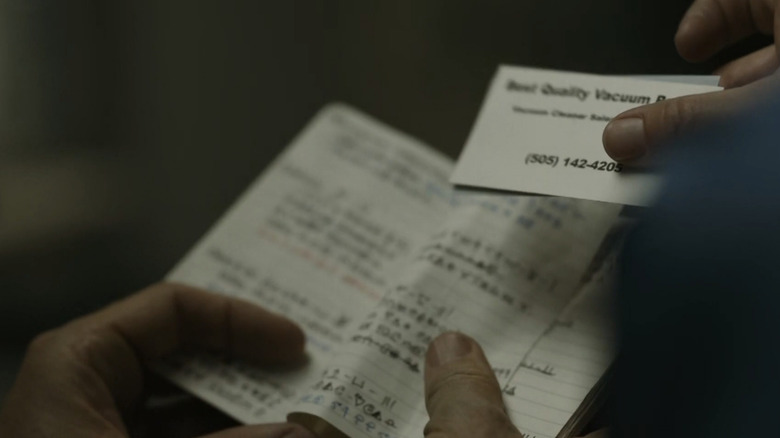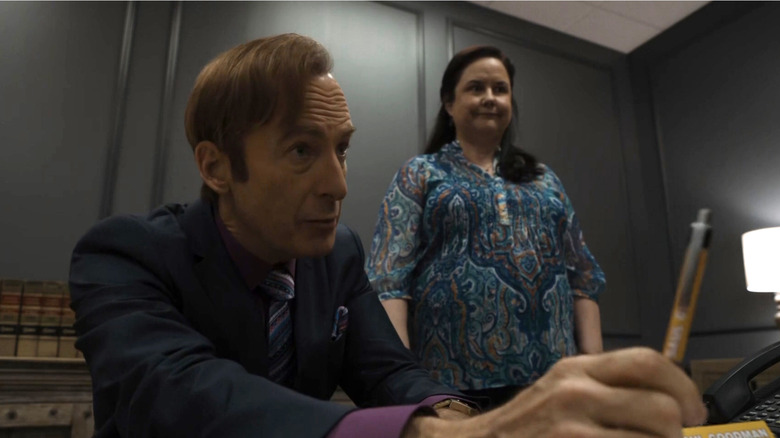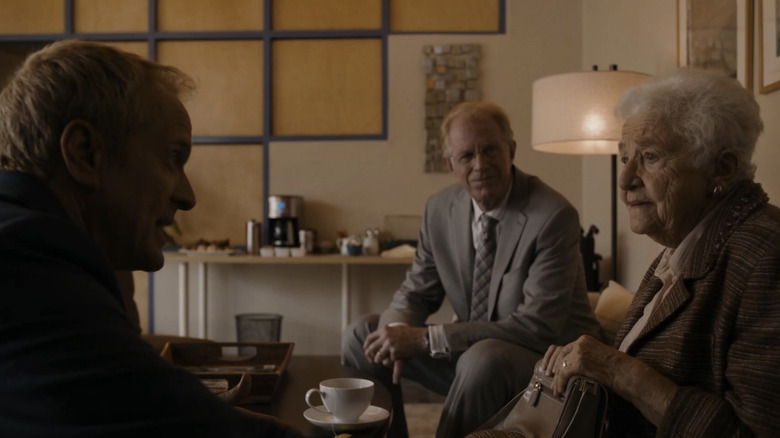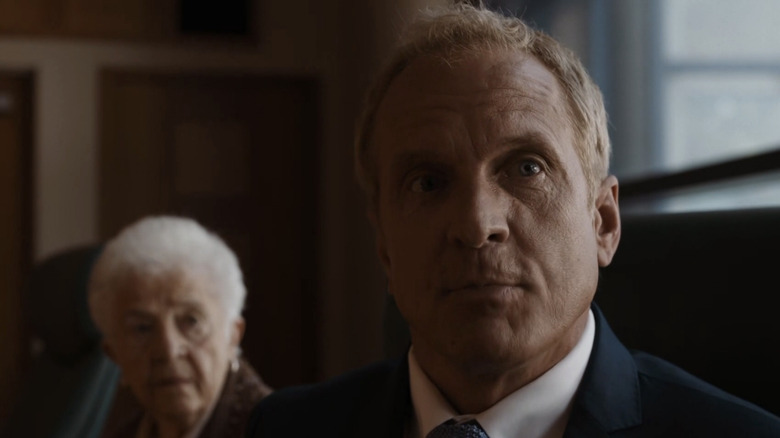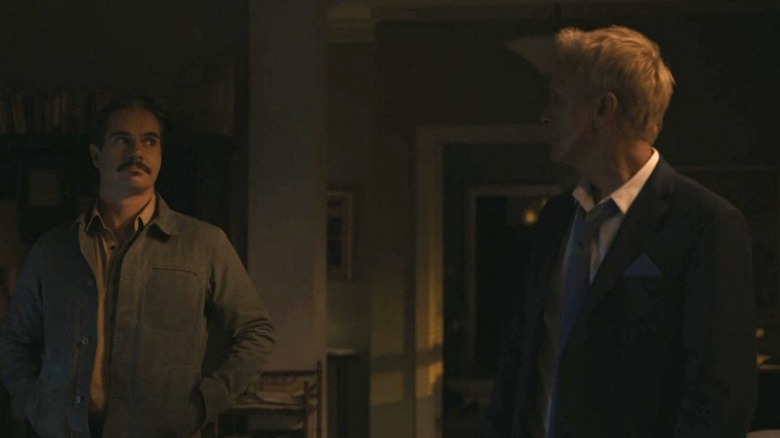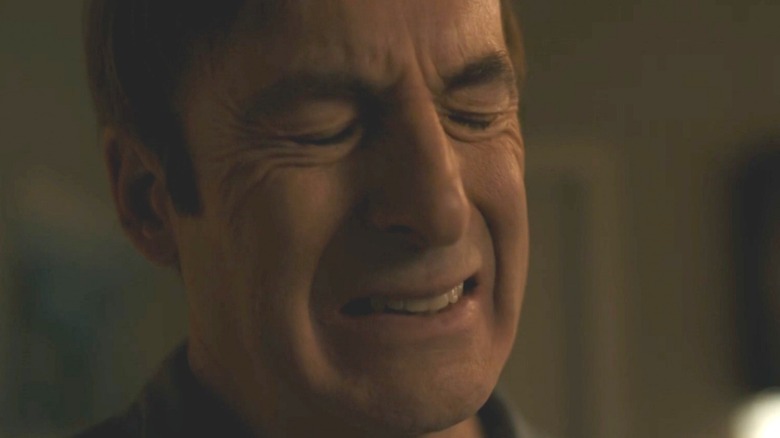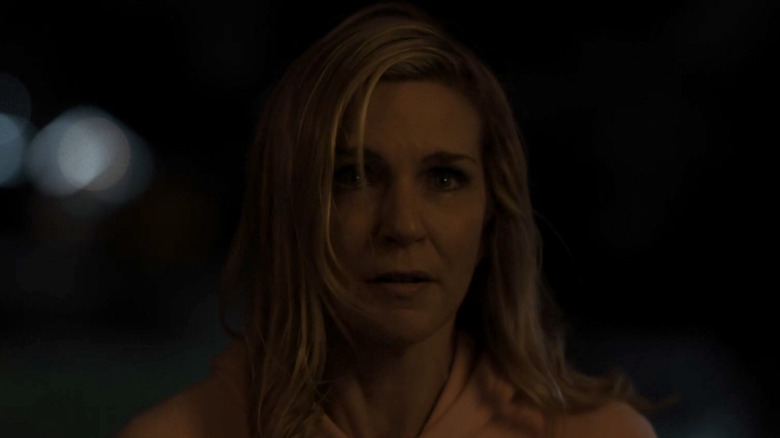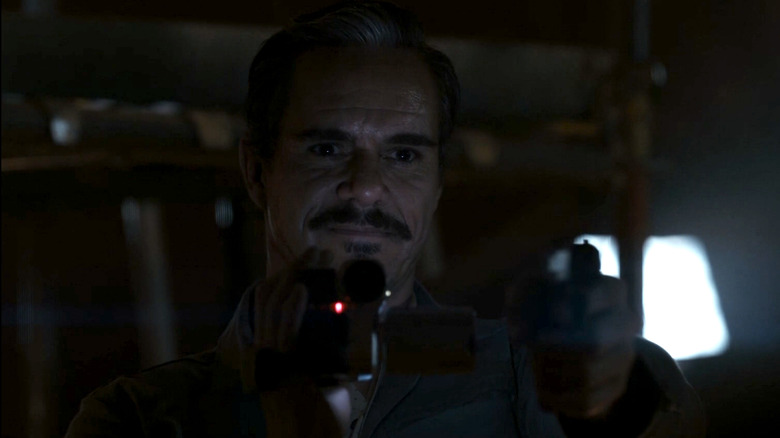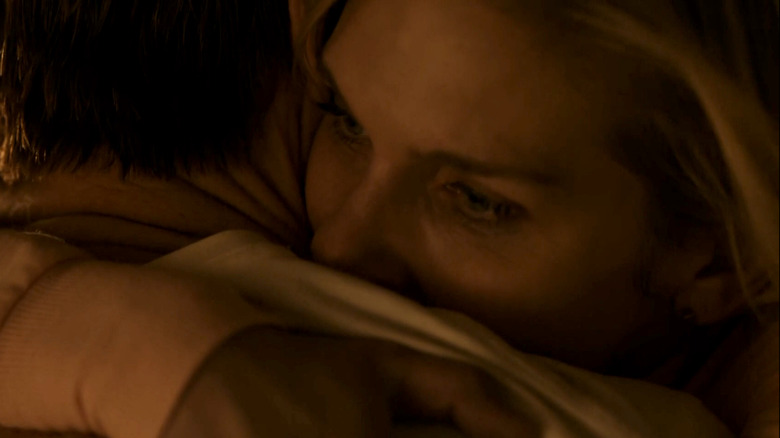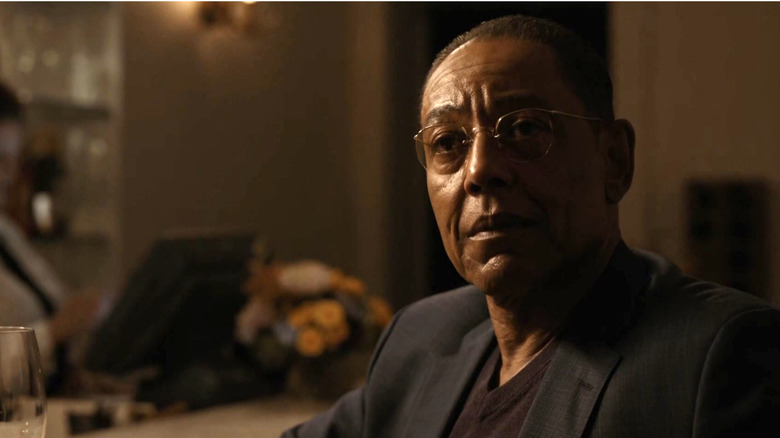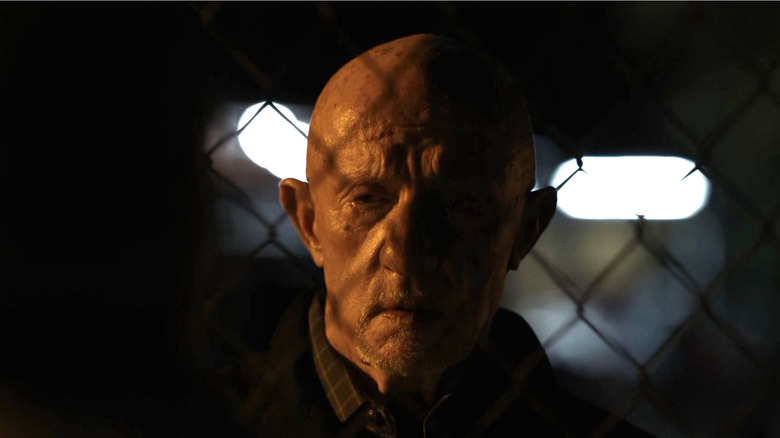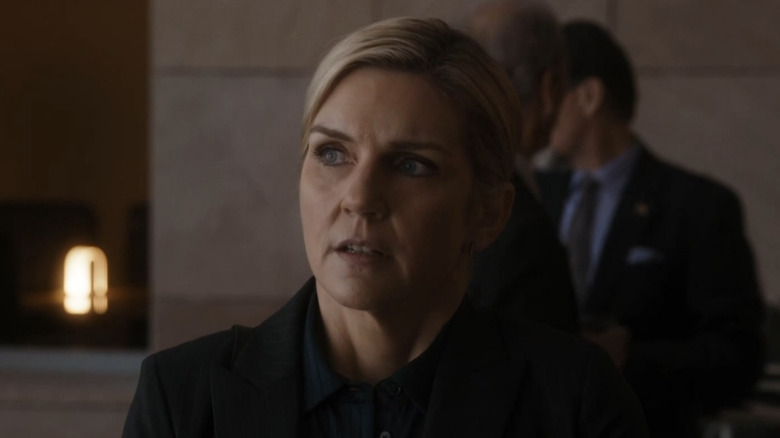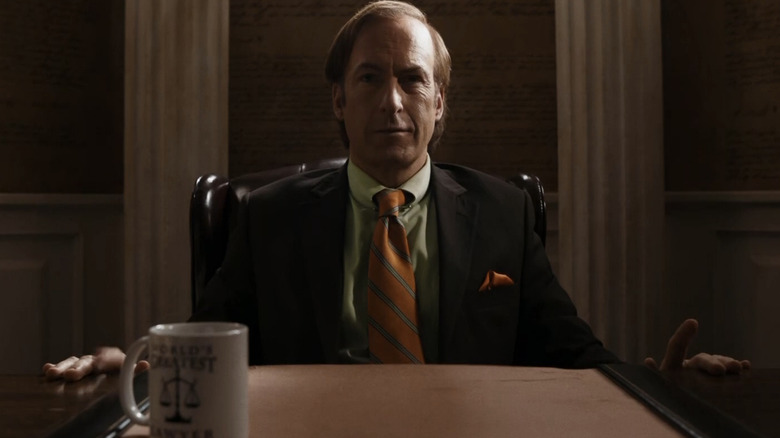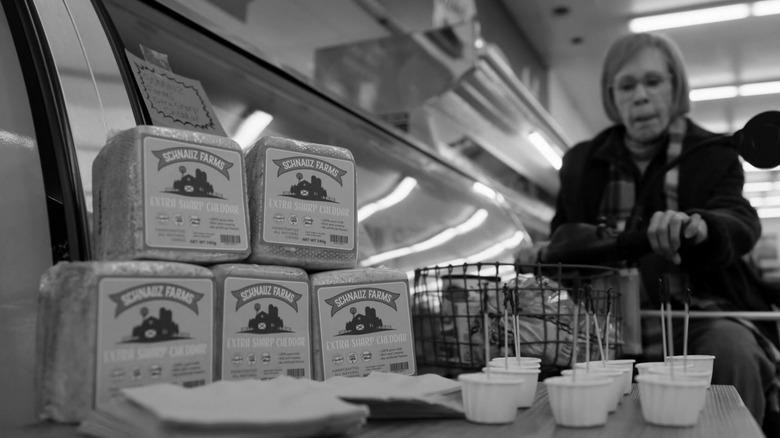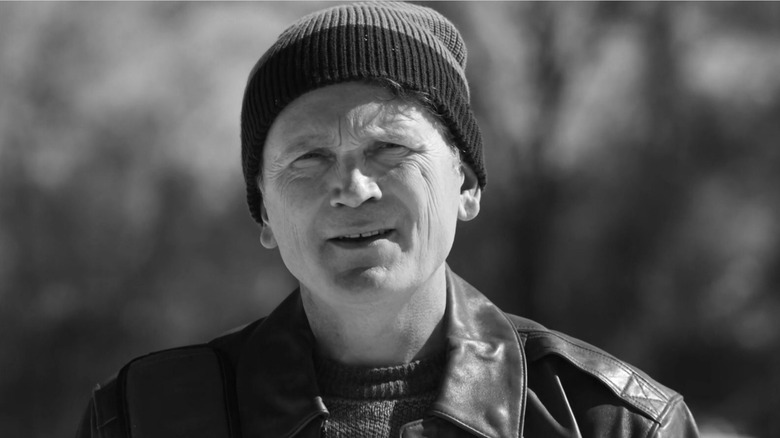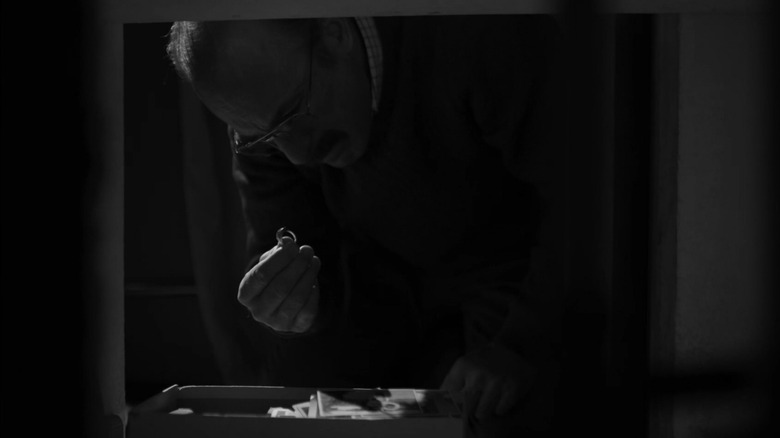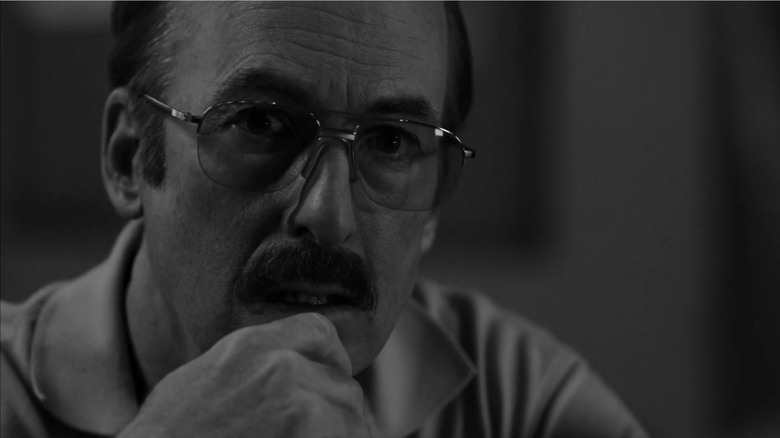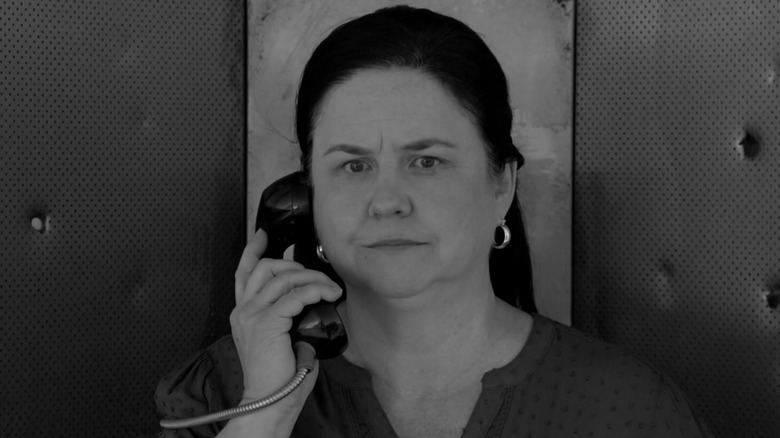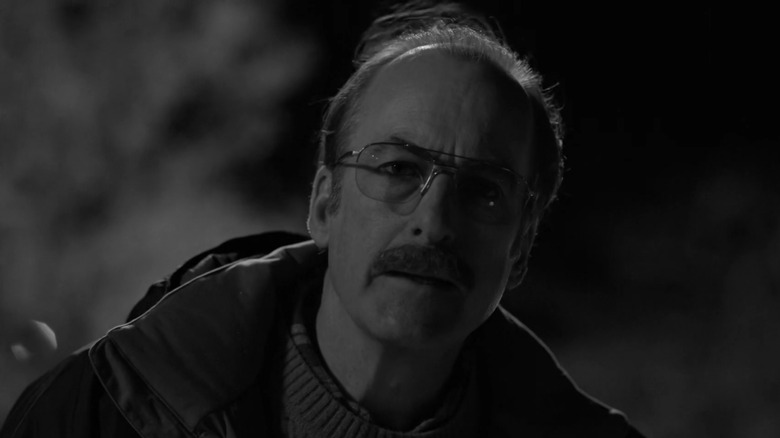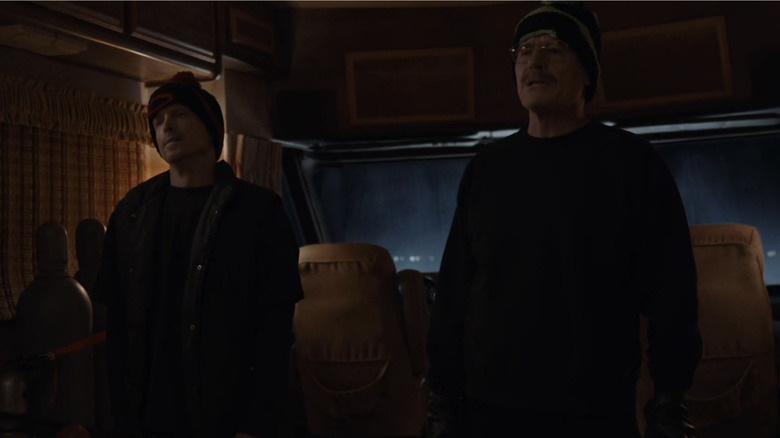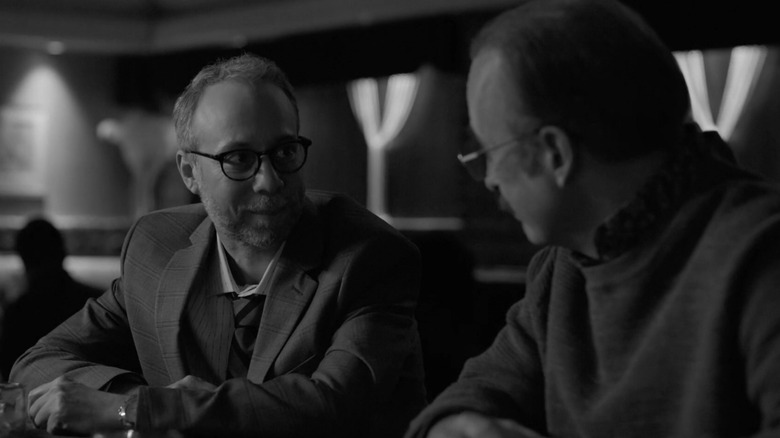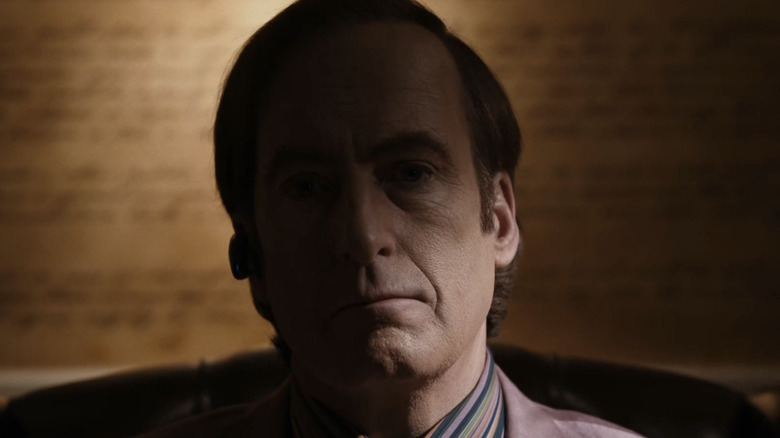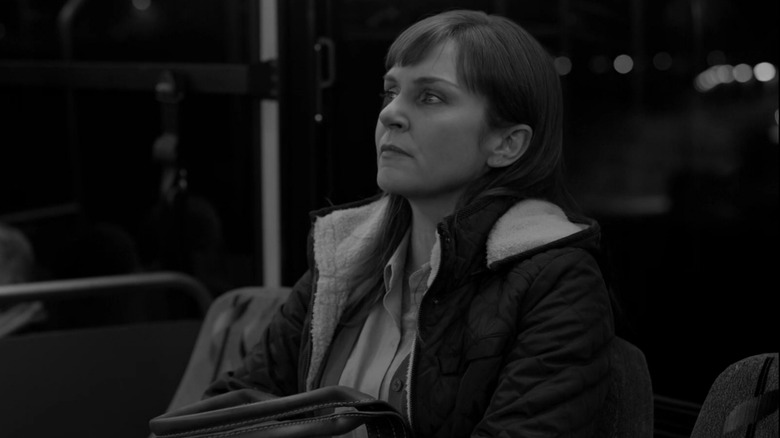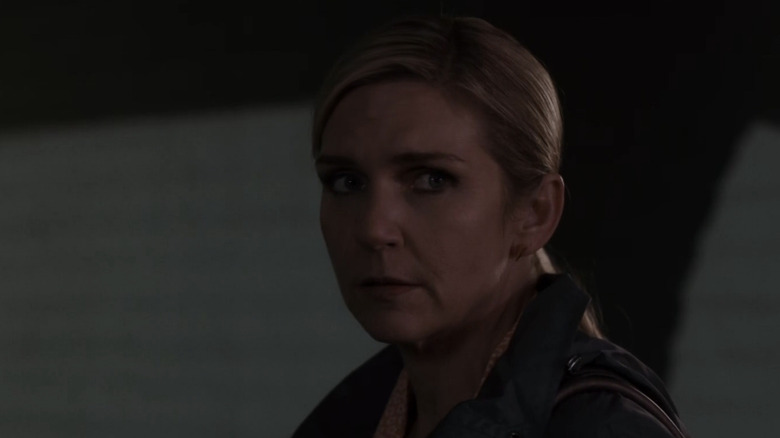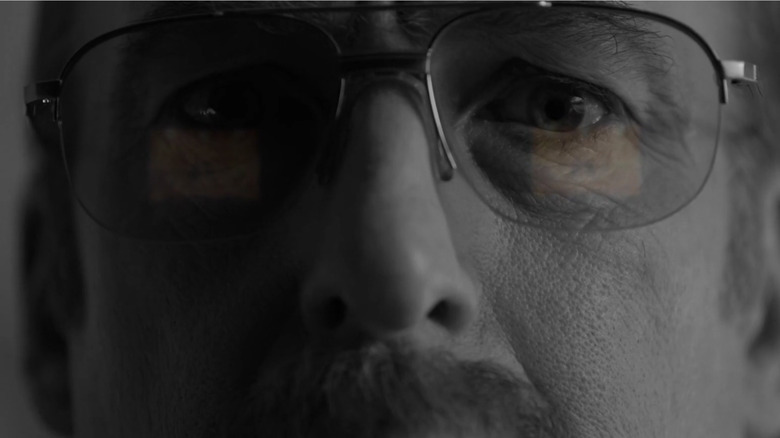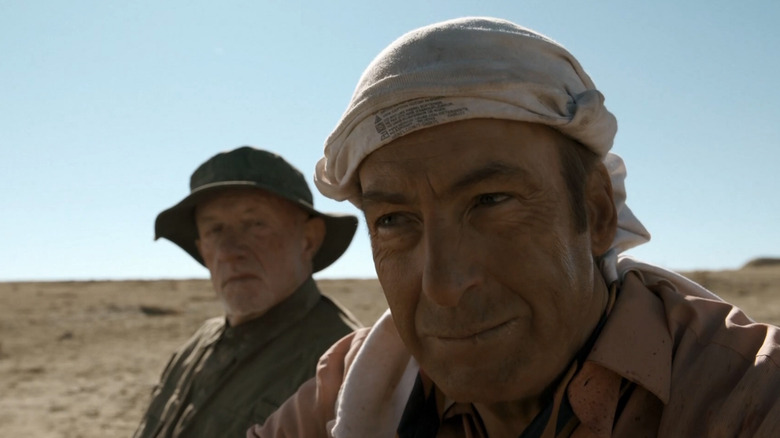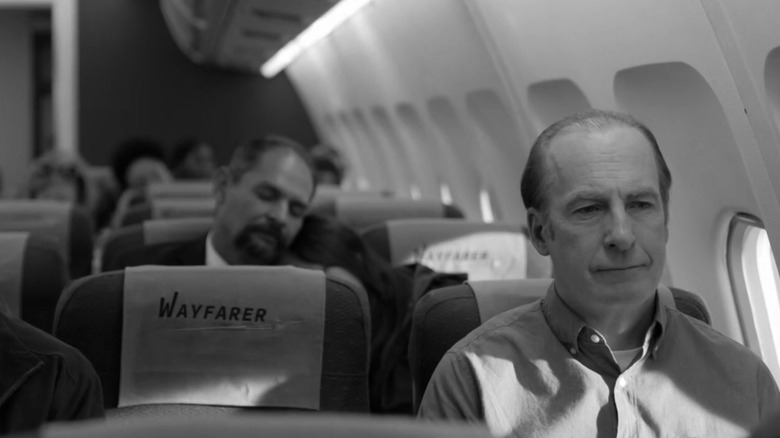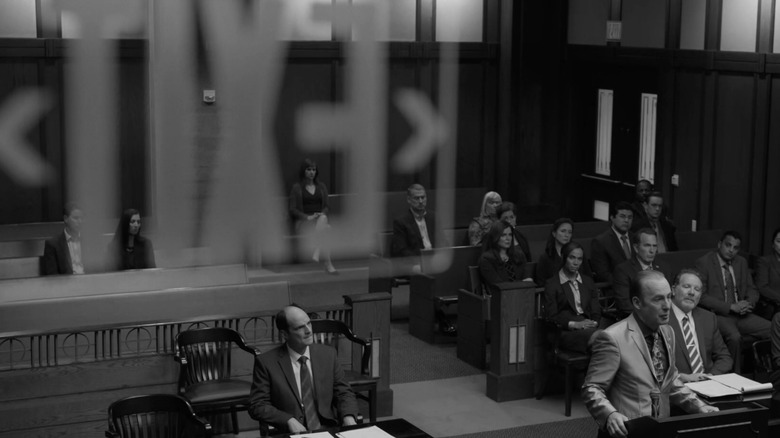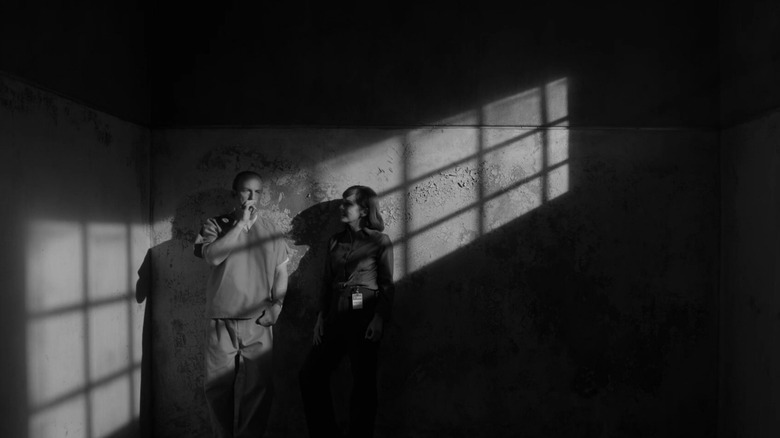Small Details In Better Call Saul Only True Fans Understood
When "Breaking Bad," one of the most acclaimed and awarded TV dramas of all time, ended its five-year run in 2013, fans at least had "Better Call Saul" to look forward to. Co-created by "Breaking Bad" captains Vince Gilligan and Peter Gould, the semi-comedic spinoff featured Bob Odenkirk reprising his role as sketchy bus-bench lawyer Saul Goodman ... or rather small-time public defender and nail salon-inhabiting lawyer Jimmy McGill as he became Saul Goodman. Set a few years before the events of "Breaking Bad," "Saul" adds substantially to the "Breaking Bad" universe of Albuquerque's seedy criminal world. That also means it's loaded with references to its parent series, not to mention clues to Jimmy/Saul's past, present, and future.
Saul was right about his future
Near the very end of "Breaking Bad," as Walt's criminal empire is crumbling and threatening to take down everybody associated with it, a panicked Saul (Bob Odenkirk) tells Walt (Bryan Cranston) that he's no longer his lawyer, but rather "Mr. Low Profile." "If I'm lucky," he goes on. "A month from now, best-case scenario, I'm managing a Cinnabon in Omaha." And while "Better Call Saul" is a prequel series to "Breaking Bad," it starts with a brief update on what happened to Saul after the events of "Breaking Bad": He's posing as a mustachioed man named Gene, who manages a Cinnabon franchise at a mall in Omaha, Nebraska.
The car makes the man
As "Better Call Saul" begins, Jimmy is tooling around Albuquerque in a tiny yellow Suzuki Esteem that has seen better days. In the pilot, he parks it outside the courthouse next to a big fancy Cadillac. That moment of unfair comparison must have stuck in Jimmy's mind because after he "becomes" Saul Goodman, he winds up driving a Cadillac nearly identical to that one. The idea that he needed to drive a Cadillac to be a legitimate lawyer was further driven home in the "Better Call Saul" episode "Marco." Jimmy's old scam partner, Marco (Mel Rodriguez), finds out Jimmy's a lawyer and assumes that he's "riding around in a white Caddy, making bank."
That nursing home looks familiar
In the "Better Call Saul" Season 1 episode "Alpine Shepherd Boy," Jimmy tries to attract aged clients needing their wills drawn up by studying the behavior of TV's Matlock, and then going where everyone loves "Matlock": a nursing home. He glad-hands the elderly in a Matlock-esque linen suit and passes out gelatin cups emblazoned with his name and the slogan, "Need a will, call McGill!" The name of that nursing home is Casa Tranquila, and it's the same place where bell-ringing "Breaking Bad" bad guy Hector Salamanca (Mark Margolis) lived.
There's graffiti left by a familiar criminal
Before he was a meth-making young adult on "Breaking Bad," Jesse Pinkman (Aaron Paul) was a troublemaking teenager. He would have been in that period of his life during the time frame "Better Call Saul" takes place in. Which is to say that the graffiti tag on the outside of a phone booth Jimmy uses on the third episode of "Better Call Saul" that spells out "JPi" was almost certainly left by a young thuggish Jesse. "Saul" co-creator Peter Gould more or less confirmed it, saying that the idea wasn't in the show's script, but that "sometimes folks in the art department or on the set add a little something."
Lots of people live on Juan Tabo
When "Better Call Saul" begins, Jimmy is working as a public defender — the "attorney that will be provided for you if you cannot afford one" as guaranteed in the Miranda rights read upon arrest. He isn't paid as much as he'd like by the city of Albuquerque for his services: $700, according to his paycheck. Also on that check: Jimmy's address of record, which is 160 Juan Tabo NE. That same street was previously mentioned on "Breaking Bad." When Walt sends Jesse to kill fellow meth-maker Gale, it's to Gale's home at 6353 Juan Tabo, Apartment 6. That means Gale lived down the street from Jimmy, who was sleeping in the back room of the nail salon that he kept as his office. (In real life, the building at 160 Juan Tabo NE really is a nail salon.)
Belize is a very important country
By the end of the first season of "Better Call Saul," Jimmy is still trying to attract elderly clients by volunteering at a retirement home, working as a bingo caller. A bunch of B numbers in a row make Jimmy slowly lose his cool. As he does so, he keeps having to vamp for B words: "'B' as in 'betrayal,'" "'B' as in 'brother,'" and "'B' as in 'Belize.' Beautiful place. So I've heard. I would love to go there, but let's face it, that's never going to happen." So far, so good for Saul, because on "Breaking Bad," "send him to Belize" was a code phrase Saul and Walt would use that meant "have them murdered."
Bank on this reference
Prior to the broadcast of the fifth episode of the second season of "Better Call Saul" in 2016, the show's official Twitter account teased that Hamlin, Hamlin, McGill would "welcome a familiar business as a new client." The client that lawyer Kim Wexler (Rhea Seehorn) brought in turned out to be Mesa Verde, a massive local financial institution. It also happens to be the same credit union where Walter White started the events of "Breaking Bad." He goes there in the pilot episode to withdraw his life savings in order to buy the RV that would become his mobile meth lab.
Mike always packs a lunch
In the "Better Call Saul" Season 1 episode "Pimento," Mike Ehrmantraut (Jonathan Banks) takes a job as a heavy on a drug deal. One of the other toughs (Steven Ogg) is perplexed that Mike brought along a sandwich — pimento cheese, of course — instead of a gun. But that's just the way Mike rolls. Back on a Season 4 episode of "Breaking Bad," Mike and Jesse Pinkman (Aaron Paul) are on a stakeout together. Mike offers Jesse a pimento cheese sandwich.
The origin of Saul's ring
After his old con partner and best friend Marco dies, Jimmy attends the funeral on the "Better Call Saul" episode "Marco." The mother of the deceased gives Marco's ring to Jimmy, which he reluctantly places on his pinkie finger. This is the same ring that could be occasionally spotted on Saul's pinkie on "Breaking Bad." The reference on "Saul" goes a little deeper. After the funeral, Jimmy and another mourner smoke a cigarette outside the church, and the other guy recognizes the ring. One of the times it's most prominent on "Breaking Bad" is when Saul holds up a plastic bag containing a cigarette loaded with ricin, which Walt eventually uses to kill Lydia.
The news of Gus's return was hiding in plain sight
Many "Breaking Bad" characters have shown up on "Better Call Saul" as younger versions of themselves. Perhaps the most memorable criminal from "Breaking Bad" was ruthless meth kingpin/fried chicken purveyor Gus Fring (Giancarlo Esposito). He showed up in Season 3 of "Better Call Saul," but that was old news to hardcore "Saul" fans, who had figured that out at the end of Season 2. How? The clues were in the season's episode titles: "Switch," "Cobbler," "Amarillo," "Gloves Off," "Rebecca," "Bali Ha'i," "Inflatable," "Fifi," "Nailed," and "Klick." Take the first letter of each title, rearrange them, and it spells out "F-R-I-N-G-S-B-A-C-K." When the code was cracked, "Better Call Saul" co-creator Peter Gould said, "I guess we really underestimated the genius and hard work of our fans."
Ken wins
Kim gets a taste of the grifter life in the Season 2 premiere episode, "Switch." After attending Marco's funeral at the end of Season 1, Jimmy announces his intention to quit practicing law. When Kim asks what he'll do instead, he shows her, zeroing in on obnoxious stockbroker Ken (Kyle Bornheimer) at a hotel bar. Posing as Viktor ("with a K") St. Clair and his sister Giselle, they pique Ken's interest with a story about a large inheritance they don't know what to do with, then proceed to polish off a high-end bottle of tequila at $50 a shot, leaving Ken with the check.
If this particular obnoxious stock bro seems familiar, he was also the object of Walter White's ire in the "Breaking Bad" Season 1 episode "Cancer Man." There, Ken's boorishness is punished when Walt sticks a wet gas station squeegee under the hood of Ken's car (which features a license plate reading "Ken Wins"), causing the engine to explode. It seems that the universe, or perhaps just Vince Gilligan, is trying to tell Ken something.
About that tequila bottle
After conning Ken out of that very expensive tequila bottle in "Switch," the bartender gifts "Giselle" with the bottle's distinctive cork, resembling a crown-like thrust of agave leaves. Over the remainder of the series, that cork will come to symbolize Jimmy and Kim's relationship, as well as the reckless streak hiding underneath Kim's straight-laced, responsible exterior. When Kim quits her lucrative banking law job to pursue a pro bono defense position at the end of Season 5, the cork is the one thing from her office that she takes with her.
However, that fictional brand of tequila, Zafiro Añejo, has more significance than Kim could even know. Eagle-eyed "Breaking Bad" fans will recognize the bottle from the Season 4 episode "Salud," where it serves as a symbol of a very different type of freedom. After years of biding his time, meth kingpin Gus Fring finally makes his move against the cartel that controls him and who murdered his partner, Max, using a poisoned bottle of Zafiro to wipe out Don Eladio (Steven Bauer) and the rest of the cartel leadership.
Poor Francesca
Much of the tragedy in the "Breaking Bad" universe comes from the corrupting influence of men like Walter White and Jimmy McGill, as the show documents how the poison in their hearts seeps out to infect those around them. Jesse Pinkman and Skyler White were perhaps Walt's greatest victims. In approaching "Better Call Saul," viewers know where Jimmy McGill is headed and worry about what his transformation into the Saul Goodman will mean for Kim.
For a prime example of this corrupting influence, look no further than the series' before-and-after portrait of Francesca Liddy, Jimmy's longtime receptionist played by Tina Parker. In "Breaking Bad" Francesca is a jaded and miserable accomplice to Saul's schemes who shakes down Walt for $25,000 over a broken glass door. On "Better Call Saul," however, we see the moment she first shakes Jimmy's hand, a bright and eager new hire at his and Kim's short-lived shared legal practice. All she wants is a fresh start after working for the New Mexico Motor Vehicle Department for nearly a decade, but like Jesse, Skyler, Kim, and many other poor souls in these men's orbits, she has no idea what she's getting herself into.
Huell's sticky fingers
"Breaking Bad" featured many audacious and intricate plans over the years. However, one moment that stretched credulity occurred in Season 4 when Saul's associate Huell Babineaux (Lavell Crawford) lifted a specific cigarette (containing a vial of poisonous ricin) from a pack in Jesse's pocket without Jesse — or anyone else — noticing. The theft was all part of a masterful plan by Walt to get Jesse back on his side in his war against Gus Fring, expertly manipulating Jesse's emotions and leading to the most explosive season finale in the show's history. But still, how did Huell swipe that cigarette? Is he just that good?
"Better Call Saul" answers that question with an emphatic yes, he is just that good. Throughout the series, Jimmy's imperious older brother Chuck (Michael McKean) suffers from a debilitating sensitivity to electromagnetism. However, in the Season 3 episode "Chicanery," Jimmy uses Huell's sticky fingers to slip a charged cell phone battery into Chuck's pocket without his knowledge. This has the ultimate effect of dramatically revealing at Jimmy's disbarment hearing that Chuck's condition was psychological, not physical, all along — a moment as explosive and devastating, in its own way, as Gus Fring's last stand.
Hiya, Ira!
Prequel films and shows will often include callbacks to their predecessors and inside jokes, both as a treat for longtime fans and to color in the detail of the world. "Better Call Saul" does this better than most, in part because it has such a rich original text to work from "Breaking Bad." We all want to know how Jimmy McGill became Saul Goodman, and we all worry about where Kim is during the events of "Breaking Bad," sure. But what about the guy who runs Saul's pest control business/meth lab cover?
Character actor Franc Ross appeared as Ira, the manager of Vamanos Pest Control, only once in "Breaking Bad," during the Season 5 episode "Hazard Pay." There, Ira's fumigation tents provide a convenient cover for Walt and Jesse's mobile meth lab. It's a role that required little of Ross other than to look just a little scraggly, but when the time came to cast the role of a small-time crook whom Jimmy hires to steal a valuable Hummel figurine in Season 4 of "Better Call Saul," producers Vince Gilligan and Peter Gould brought back Ross, as Ira, once again. With that decision, this petty burglar becomes a man with a future, and that exterminator becomes a man with a past.
Lalo and the bell
For most of the run of "Better Call Saul," the show depicted two largely disconnected worlds. Viewers got to know the legal world of Jimmy McGill, which was mostly new to the series, while learning more about the world of Mike Ehrmentraut, Gus Fring, and the cartel, which viewers first became familiar with in "Breaking Bad." However, Season 4 saw many of its characters take giant steps toward being the people we know they will become. These transitions included Jimmy officially taking the Saul Goodman name, Gus beginning construction on the super lab, and Hector Salamanca's stroke, which led to his relocation to the Casa Tranquila nursing home.
However, just as things were starting to get a little too familiar, a new face arrives at the end of the season with Eduardo "Lalo" Salamanca (Tony Dalton), as charming a monster as the "Breaking Bad" universe has ever seen. Lalo comes to America to take over the business from Hector and generally be a thorn in Gus Fring's side. He also comes bearing a very familiar gift for his tìo in a brass bell taken from a hotel that he and Hector burned down together after murdering its owner. This bell will become Hector's primary means of communication on "Breaking Bad," and eventually, the device that will take Hector's final revenge against Fring.
Half measures
Mike Ehrmentraut (Jonathan Banks) spends a lot of time around people he doesn't really like, especially in his job as an all-around fixer and bag man for Gus Fring. He finds an unexpected kindred spirit, though, in Werner Ziegler (Rainer Bock), the German lead engineer constructing the superlab. Werner and the other engineers are working in complete seclusion, and Mike can see that he is cracking under the pressure. When Werner asks for a furlough to return to Germany for a few days to see his wife, Mike refuses but allows him to have extra time to talk to his wife on the phone. That small kindness leads to Werner escaping from the compound and going on the run.
When Mike tracks him down, there is no other option than to kill him. Werner offers to keep quiet and give all his money back to Gus, but none of it matters. The situation calls to mind what Mike would later tell Walter White in "Breaking Bad" Season 3 about the folly of taking half measures when a full measure is needed. Mike's compassion got the better of him, and now someone has to die because of it. It's a lesson he would learn more than once.
Vacuum repair
Each season begins with a black-and-white flash-forward to the present day, showing Jimmy's drab new life. Jimmy is now known as Gene Takovic, a Cinnabon manager at an Omaha mall who lives in constant fear of being discovered by the feds, the cartel, the nazis, or all three. After a fainting spell at the top of Season 3, Season 4 sees him picked up from the hospital by a cab driver (Don Harvey) with an Albuquerque Isotopes logo hanging from his mirror. Terrified, Jimmy flees to a diner on the state line at the start of Season 5. When he tentatively returns to his Cinnabon job, he is confronted by the cab driver, who appears to be nothing more than a pushy Saul Goodman fan.
Nevertheless, Jimmy runs to the stockroom and makes a phone call. A familiar voice answers when Ed, the vacuum cleaner repairman who disappears people on the side, picks up. Ed is played by legendary character actor Robert Forster on "Breaking Bad" and in the 2019 sequel film "El Camino." As reported by Entertainment Weekly, Forster's brief scene here was actually filmed during the production of "El Camino," long before anything else in Season 5 was filmed. Sadly, Forster would not live to see Ed's final appearance as he passed away in October 2019, several months before Season 5 would air. The premiere episode is dedicated to his memory.
Old Hank, new Hank
Season 5's "The Guy for This" brings back three fan favorites and sets up a major piece of "Breaking Bad" lore. When low-level Salamanca dealer Domingo Molina (Max Arciniega) is picked up by Albuquerque PD, Nacho and Lalo hatch a plan to get him turned into a confidential informant, feeding false information to the DEA. The two agents Domingo talks to are Hank Schrader (Dean Norris) and his partner Steven Gomez (Steven Michael Quezada).
Hank, of course, is Walter White's brother-in-law, while Domingo, soon to be known as Krazy-8, will one day be the first person Walt intentionally kills in Season 1 of "Breaking Bad." In fact, Domingo's confidential informant status is what gets Hank on the trail of the mysterious Heisenberg in the first place.
Hank comes off as a glad-handing jock at the start of "Breaking Bad," the polar opposite of his brother-in-law. However, as the series continues, Hank gains layers, in no small part due to Norris' excellent performance, and by the final season he was one of the most nuanced and sensitive characters on the show. "Better Call Saul" sets the clock back to a more alpha male period in Hank's life, but it doesn't forget the depth that he's shown. The boorish side of Hank is real but also a performance, in much the same way that Saul Goodman is both an act and an expression of Jimmy's true self.
Finger guns
At the end of Season 4, Jimmy gives an emotional speech about his late brother Chuck at the hearing to reinstate his law license. The speech works, and Jimmy is thrilled — not just to be able to practice law again but to have bamboozled the reinstatement committee. This 180-degree turn startles Kim, who was as convinced of his sincerity as anyone else. However, the true twist of the knife comes when Jimmy requests a DBA (Doing Business As) form so that he can work under a new name. He turns to Kim, shoots his index fingers out at her, and says, "'S'all good, man!"
Kim gets her chance to return the finger gun gesture at the end of the following season, though. As Jimmy wrestles with what it means to be a cartel lawyer, Kim has been having a career crisis of her own. She quits her job at a swanky practice and turns to pro bono defense work, and when her and Jimmy's old boss Howard Hamlin (Patrick Fabian) hears this, he assumes (not incorrectly) that Jimmy is a bad influence. The suggestion so enrages Kim that she spends that night dreaming of ways to ruin Howard, both personally and professionally. When Jimmy, troubled by seeing his own impulses reflected back at him, asks if she's serious, Kim spins around and gives him finger guns. But not just that, she shoots them and blows off the barrels. It's both a playful and troubling moment, as Jimmy and the audience wonder if straight-laced, responsible Kim is about to break bad.
The Goodman Estate
Season 6 throws viewers a curveball. For the first time, a new season doesn't start with a black-and-white flash-forward to the miserable life of Gene Takovic. Instead, we're treated to a different type of flash-forward, maybe even a flash-sideways, as movers clean out the tacky Albuquerque home of Saul Goodman. A roving camera captures every gaudy detail, from the black and gold color scheme to the neo-classical columns and the solid gold toilet. This is the first time we have ever seen Saul's house from the "Breaking Bad" years, and it feels all-too appropriate for that version of the character — but still a million miles away from the apartment that Jimmy and Kim share.
Easter eggs are sprinkled throughout. Despite this being Saul's house, traces of Jimmy McGill can still be seen. Fans will notice the MBT orthopedic sneakers he used to powerwalk around the mall, the film crew ball cap he wore when running Saul Goodman Productions, his Ritchie Blackmore-signed Fender Stratocaster. The fact that all of those are callbacks to Season 3 suggests that this season, the last featuring Michael McKean as his brother Chuck, might hold some special significance to the show's endgame.
In Saul's bathroom we see prescription drugs, including Viagra and Minoxidil — which is used to stop hair loss — representing the toll that being Saul Goodman takes on Jimmy. Most significantly, Kim's Zafiro Añejo cork falls out of a bureau and into the street, unnoticed and abandoned. The sequence ends with the camera lingering on the agave-shaped bottle top. Of all the questions for this final stretch of episodes to answer, what happens to Kim is the most pressing.
Albuquerque Country Club
The first step of Kim and Jimmy's plan to professionally and personally ruin Howard Hamlin (Patrick Fabian) involves planting cocaine in his locker at the Albuquerque Country Club. The country club counts ABQ bigwigs such as Howard, Clifford Main (Ed Begley Jr.), and Kim's old Mesa Verde boss Kevin Wachtell (Rex Linn) as members. Kevin sees Jimmy trying to worm his way into the club and puts his foot down with the club manager (James Urbaniak), but when the manager attempts to get Jimmy to leave, Jimmy calls out the club for anti-semitism (a callback to his stated reason for the Saul Goodman name change in "Breaking Bad").
Albuquerque Country Club had made an appearance in "Better Call Saul" Season 5, but its existence and location were established much earlier. In the Season 1 finale of "Breaking Bad," the house belonging to Jesse Pinkman's deceased aunt, where Krazy-8 was killed and Emilio's body was dissolved in acid, is on the market. Showing it to prospective buyers, the realtor notes that it is "within walking distance to the country club." Knowing that Jesse cared for his aunt as she died of cancer, it's entirely possible that Jesse is just a stone's throw away at the moment when Jimmy slips drugs into his former boss' locker.
Twins and cars
Nacho (Michael Mando) begins Season 6 on the run. After allowing Gus' mercenaries into Lalo's compound at the end of Season 5, he takes off into the woods and ends up hiding out in a run-down motel just south of the border. Gus' henchman Tyrus (Ray Campbell) tells him to wait and a truck will stop by to pick him up in a few days. However, Nacho is now the cartel's number one enemy, and soon his cover is blown. When Salamanca gunmen converge on the motel, Nacho makes a daring escape in a hot-wired pickup truck.
It is a terrifically tense scene with an unexpected visual foreshadowing. Leading the cartel forces are the fearsome Salamanca twins Marco and Leonel (Luis and Daniel Moncada). When Nacho gets the stolen truck started, he barrels in reverse toward the twins. They neatly step out of the way of the truck, but the moment visually recalls their ultimate fate at the hands of Hank Schrader in Season 3 of "Breaking Bad," when Hank's SUV crushes Leonel's legs.
This encounter is not nearly as deadly for the twins, or for Nacho, who escapes the motel parking lot with his life, but now must consider the very real possibility that Gus has abandoned him to the cartel to tie up loose ends.
The Kettlemans return
The second part of Jimmy and Kim's plot against Howard involves spreading the rumor of Howard's drug use around the Albuquerque legal community through an unwitting patsy. Jimmy needs to find someone whose greed will allow them to be easily led by the nose.
He finds that person, or rather persons, in Craig and Betsy Kettleman, the hapless criminal couple whose embezzlement of county treasury funds and attempt to implicate Jimmy in a bribery scheme was a key plotline in Season 1. Now working as tax preparers out in the middle of nowhere after Craig's 16-month prison sentence, the couple holds a bitter grudge against Jimmy. However, they are unable to help themselves when he dangles a carrot in front of them in the form of a civil suit alleging that Howard's drug use impaired his counsel in their case.
Of course, there is no real possibility of a lawsuit, nor does Jimmy really want to represent them. Instead, he is counting on them to take his idea and run to every other big-name lawyer in town, starting with Clifford Main, who just saw a baggie of cocaine fall out of Howard's country club locker. When the Kettlemans figure out Jimmy's scheme and threaten to go to Howard, Kim buys their silence with the correct assumption that they are fleecing their rural clients. She may end up buying something else from them, too, as the episode ends with her eyeing the very familiar blow-up Statue of Liberty decorating the front of their building.
Kim's multi-colored sticky notes
In the third episode of Season 6, "Rock and Hard Place," we see Jimmy and Kim's battle plans in their secret war against Howard, marked out in multi-colored sticky notes on the back of a painting in their apartment. We don't get a very good look at the notes themselves, and what we do see is indecipherable. They include a drawing of a carrot (perhaps a reference to the "carrot and stick" used on the Kettlemans in Episode 2), notes that simply say "phone call?" and "costume," as well as one that is just a cartoon angry face.
All will presumably be made clear as their scheme enters its endgame. However, what's important is not what is written but what is written on. Longtime "Better Call Saul" fans will no doubt recognize the multi-colored sticky notes from Kim's montage in the Season 2 episode "Rebecca." On the outs with Howard and Chuck over her association with Jimmy, Kim (still working for HHM at the time) is relegated to document review duty. But even while toiling away highlighting paper after paper, she hustles to bring in new clients for HHM, using those sticky notes to keep track of her prospects. The montage, scored by the Gipsy Kings' Spanish language cover of Frank Sinatra's "My Way," is a great showcase not just for Rhea Seehorn but for Kim as well, an early glimpse of her nearly pathological need to power through bad situations.
Gotta make it look real, right?
Nacho is brought back over the border in a hidden compartment underneath the bed of a Los Pollos Hermanos truck. Nacho, who survived the attack on Lalo's compound at the end of Season 5 and managed to escape the Salamanca cousins in the previous episode's motel siege, knows that he is a dead man. Ultimately, he is doomed to be killed either by the cartel or Gus Fring — the "rock and hard place" of the episode's title. He agrees to be "captured" by Fring and to later "confess" to the Salamancas that he betrayed Lalo at the behest of a rival Peruvian cartel in exchange for a quick death and his father's safety. However, when Nacho arrives, Fring decides that his face is not sufficiently beaten up to make their ruse believable. "Gotta make it look real, right?" he says to Mike, who pours them both a shot of whiskey before beating him bloody offscreen.
This is not the first time Nacho has been subjected to extreme violence to sell a deception. In Season 4, when Gus discovers that Nacho caused Hector Salamanca's nearly fatal heart attack and stroke (using a bottle of fake pills), he uses that knowledge to press Nacho into acting as a cartel informant. To make sure he avoids suspicion and remains in the cartel's good graces, Gus has his men stage an attack on Nacho and his partner Arturo (whom Gus' men had already killed), leaving Nacho shot through the side in the middle of the desert, injured but not in danger of dying.
Mike and Nacho
The "Breaking Bad" universe is so skilled at getting its characters into no-win situations and then having them wiggle free through some clever way that it is ironically more shocking when a no-win situation turns out to be exactly that. Such is the case with Nacho, marked for death by the cartel for his role in the death (or so they think) of Lalo Salamanca and an expendable witness to Gus Fring's failed coup. In his last living moments, he tells Juan Bolsa and the Salamancas what Gus wanted him to say, but instead of staging an escape and getting gunned down by Victor, as was the plan, he makes his final stand.
In a blistering performance by Michael Mando, Nacho unloads his contempt for the cartel and confesses to causing Hector's stroke. He uses a shard of a drinking glass hidden in his hand to break free from his zip tie and hold up Juan Bolsa with his own gun. But rather than murder the cartel leader, he turns the gun on himself.
Mike watches this from behind the scope of his sniper rifle, far away. The two had been partners of sorts from the beginning of the series. Mike recognized that Nacho was a good kid who went down a dark path, just like his own son Matt did years before and just as Jesse Pinkman will do years later. Nacho's death, like Werner Ziegler's at the end of Season 4, will no doubt haunt Mike. Though we know that Mike will stay with Gus in the long run, their immediate relationship will very likely suffer in the aftermath of this devastating loss.
Wendy and the Crystal Palace
After an episode that was relatively light on Jimmy and Kim, Episode 4 ("Hit and Run") gets into the weeds with our favorite married lawyers and packs in several high profile callbacks to "Breaking Bad." First and foremost is the first "Better Call Saul" appearance of the Crossroads Motel, nicknamed "The Crystal Palace" by Hank Schrader way back in Season 1 of "Breaking Bad" when attempting to scare Walt Jr. straight. The motel is apparently Albuquerque's number one spot for junkies, dealers, and sex workers of all stripes, and for their next play against Howard, Jimmy and Kim hire the services of the palace's most famous resident, Wendy (Julia Minesci).
Last seen serving as Jesse Pinkman's lookout in "Breaking Bad" Season 3, Wendy is put to more public use here, as Jimmy, hilariously disguised in his best Howard Hamlin costume (complete with a deep tan and blonde highlights), borrows Howard's car and throws Wendy out of it — right in front of where Kim and Cliff Main (Ed Begley, Jr.) happen to be having a business lunch. The plan goes off nearly without a hitch, though Wendy's love of Mug Root Beer — a callback to her testimonial ad which ran on the AMC website as a webisode during Season 2 of "Breaking Bad" — almost throws off their timing.
Enter Spooge
Jimmy's usual glad-handing and stuffed animal bribes around the courthouse are given the cold shoulder, as word has gotten around that he represented Lalo Salamanca (under an assumed name) in court. His newfound status as a cartel lawyer may have lost him a few old friends, but he soon finds that it has made him a great many more new friends, as Mrs. Nguyen's (Eileen Fogarty) nail salon is overrun with a menagerie of tweakers, bikers, and assorted dirtbags eager to have Saul Goodman as their counselor. A prospective client named Spooge (David Ury) lays it out plainly to Jimmy: They want him because he is Salamanca's man.
"Breaking Bad" fans might themselves feel a tweak at the sight of Spooge — a tweak of familiarity, that is. He is much more put together while waiting his counsel in Saul's nail-salon-cum-office-lobby, but he is no doubt the same addict who will one day mug Skinny Pete (Charles Baker) and steal his meth, only to get his head smashed in by a stolen ATM in the "Breaking Bad" Season 2 episode "Peekaboo." His doom, much like Jimmy's, is still years away, but the seeds have been planted.
Kim and Mike
Once upon a time "Better Call Saul" had two mostly separate, mostly equal storytelling tracks: Jimmy's adventures in the Albuquerque criminal ecosystem, and his adventures as a fledgling lawyer. Every so often those tracks would merge, only to split back apart; one set of characters rarely if ever interacted, or even knew anything about the other. As Jimmy began to work as Saul Goodman, and to live as him too, those tracks began to converge more and more, but there were still some surprising boundaries that had yet to be crossed.
Episode 4, directed by Rhea Seehorn, is the first of the entire series in which Kim and Mike meet and talk face to face. Kim has spotted a mysterious car following her around town; when she confronts the driver, he drives away. Later, after Kim has spent the day meeting with clients at a Mexican restaurant, Mike strikes up a conversation, letting her know that the men in the car were his guys; he's keeping an eye on Kim and Jimmy because of Lalo. Fans looking forward to a face-off between the show's two most subtle actors were not disappointed: When Kim states that Lalo is dead, Mike gives her a hard look and the smallest of head nods, and Kim reciprocates with an inscrutable change of expression of her own. Everyone is on the same disturbing page; Lalo is alive. When Kim asks why Mike is telling her this instead of Jimmy, Mike reveals himself to be as big a Kim fan as the rest of us: "Because I think you're made of sterner stuff."
The Office
Episode 4 begins with the chronological first appearance of the Crystal Palace and ends with the first appearance of a different landmark: Saul Goodman's office, the strip mall "cathedral of justice," to borrow Kim's phrase from earlier in the season. After the nail salon is flooded with potential clients drinking up all the complimentary cucumber water, Mrs. Nguyen finally evicts Jimmy, which sends him on a search for somewhere good and cheap to relocate. As they peer in through the dusty plate glass windows, Seehorn's camera shoots them from inside the storefront, evoking memories of Saul's waiting room from "Breaking Bad." Though this is Saul's new home, we haven't seen the last of the nail salon, as Jimmy will attempt to sell it to Jesse as a money laundering scheme in Season 3.
The revelation that Lalo is alive weighs heavily on Kim in this scene, but she chooses not to tell Jimmy, letting him bask in the glow of the bright future in his mind. For Jimmy, that future involves the two of them, but can the same be said of Kim and her dreams of a pro bono, socially conscious legal practice? She is notably missing in "Breaking Bad"; could it be that this moment, in which she withholds the fact that Lalo may be coming after them, is the beginning of the end?
I get a say in the decorating
Episode 5 marks the return of Francesca (Tina Parker), whose brief tenure at the short-lived Wexler McGill law office in Season 3 ended abruptly when Jimmy's license was suspended. She has been offered a job manning the reception desk for the newly formed Saul Goodman & Associates. The only problem is that the reception desk is nothing more than a folding table with a telephone, and the office remains an empty storefront with a toilet in the middle of the floor as we saw in the previous episode. Francesca rightfully balks. She sees Jimmy's name change, Kim's absence from the practice, and the line of ne'er-do-wells waiting outside as one red flag after another. However, money talks. After Jimmy agrees to double her salary and offers her a cash "signing bonus" out of his wallet, she takes the job with one condition — "I get a say in the decorations."
Francesca's request calls back to her first appearance in the Season 3 episode "Witness" when Jimmy asks her opinion on the poorly thought-out WM logo he has painted on the new Wexler McGill office. She notes in that scene that "the M is a little crooked" and Jimmy, to his chagrin, sees that she's right. The callback to that moment here leaves us to consider how much of Saul's tacky, ostentatious aesthetic actually comes from Francesca.
I coulda been a contender
In Episode 5, Howard has finally put the pieces together and realized that Jimmy is behind the baggy of drugs found in his country club locker, the Kettlemans' claims of misconduct due to Howard's supposed drug use, and the scene of Wendy getting pushed out of his car directly in front of Cliff Main. Therefore, he does what any normal person in his position would do — he lures Jimmy to a boxing gym under the guise of being a prospective client, then challenges him to a match. Jimmy, when confronted, doesn't own up to any of his chicanery, but he does join Howard in the ring. "You must have gotten into a few good scrapes in the old neighborhood," Howard goads. "Yeah," Jimmy responds. "I coulda been a contender."
Jimmy's line is, of course, a reference to the Marlon Brando classic "On the Waterfront," but it's also a reference of sorts to Jimmy's "Network" moment with Howard in the show's very first episode. Jimmy has a habit of hiding his discomfort and anger behind comedy and movie references, and Howard has always subtly (or not) looked down his nose at him. Even his suggestion that he and Jimmy "punch it out" is rife with condescension. Later, as Jimmy nurses a black eye, he wonders out loud to Kim why he got into the ring at all, instead of simply walking away from Howard, but we know the reason. It's the same anger and insecurity that drove Walter White down his dark path.
I fight for you
Just as Francesca has inserted herself into the Saul Goodman hype machine, Kim remains vicariously living through Saul's war on good taste and subtle messaging. After his boxing match with Howard, Jimmy attempts to apply concealer to his black eye, insisting to Kim that he has court in the morning and can't show up in front of the judge "looking like Leon Spinks." Kim, however, sees the shiner in a more positive light; it seems only natural to her that a character like Saul Goodman would strut into court with his face bashed in. She even comes up with a solid slogan off the top of her head — "Saul Goodman: I fight for you!"
If that sounds familiar, it's because that actually was (or rather, will be) a Saul Goodman commercial. Filmed during Season 4 of "Breaking Bad" and available as a DVD extra, the ad specifically targets combat athletes who have lost revenue due to injury. The end of the ad features Saul in boxing gloves, punching toward the camera, almost exactly how Kim imagines it years earlier while sitting in the bathroom she shares with Jimmy. One of the biggest questions of the series is what happens to Kim, as she's never seen or referenced on "Breaking Bad." This moment suggests that maybe she was there for some or all of "Breaking Bad" as a silent partner, just out of sight.
In Liebe ... Deine Jungs
Lalo Salamanca lives ... in Germany. Episode 5 begins with a good old-fashioned montage of something getting made — a staple of the "Breaking Bad" and "Better Call Saul" visual style. Here, a person in a protective white suit pours liquids and powders into a bubbling container. At first, we might wonder if this is yet another glimpse into the world of crystal meth production; instead, it appears to be a commemorative paperweight, an engineering ruler suspended in polyurethane and inscribed with "In Liebe ... Deine Jungs," which roughly translates to "With love ... your boys."
By the end of the episode, we learn that the paperweight was made for Werner Ziegler, the head engineer on Gus' superlab project whose death at the hands of Mike at the end of Season 4 was covered up as an accident. The "boys" referenced here were the other engineers whom Werner supposedly saved in his final moments. That was the story told to Werner's wife Margarethe (Andrea Sooch), who in turn tells it to a handsome American named Ben sitting in a German bar. "Ben" is our man Lalo, of course, and his subtle romancing of Margarethe is a play to get into her home to search for evidence of whatever Werner was doing out in the desert for Gus. The world thinks Lalo is dead, and like Walter White in the final episode of "Breaking Bad," that somehow gives him the ability to appear and disappear at will, breaking into the Ziegler home and rifling through Werner's old papers for some clue. We don't yet know if he found anything of note. When Margarethe returns home unexpectedly soon, Lalo disappears through a window.
Young Kim
Season 6 Episode 6, "Axe and Grind" returns to the world of Omaha in the mid-1980s and the troubled childhood of Kim Wexler. Last seen in Season 5's "Wexler vs. Goodman," young Kim (Katie Beth Hall) waits in the manager's office of a department store. She's been caught trying to shoplift a necklace and a pair of earrings, retail price $34.50 plus tax, and her mother (Beth Hoyt) reads her the riot act in front of the sympathetic manager Mr. Pearson. On a show like "Better Call Saul" we're accustomed to one con or another being pulled at any given moment, and sure enough, Mrs. Wexler's outraged act in front of the manager is just a ploy to get Kim off the hook. She even lifts another jewelry set to give Kim as a kind of reward. "I didn't know you had it in you," Mrs. Wexler says.
Where the flashback opening scene in "Wexler vs. Goodman" is an early example of Kim's belief that she can turn any bad situation good through sheer willpower, the flashback in "Axe and Grind" gives us some insight into her fondness for Jimmy's petty criminal ways; director Giancarlo Esposito, stepping behind the "Saul" camera for the first time, frames the moment when Kim's mother drops the concerned parent act much like Jimmy's "S'all good, man!" heel turn in the Season 4 finale, holding the camera on Kim's reaction to being an unwitting stooge. But the scene also serves as something of a warning to viewers as the series heads into its final episodes: Jimmy, despite what Howard Hamlin might think, did not corrupt Kim or lead her astray unwillingly. Kim Wexler can break bad all by herself.
Reunion Tour
"Axe and Grind" brings back a number of notable "Better Call Saul" characters that haven't been seen in a season or more, possibly as a last hurrah as the series moves into its endgame. There's the cold open featuring young Kim and Mrs. Wexler, of course. In present day, Jimmy and Kim check in on shady veterinarian Dr. Caldera (Joe DeRosa), who is moving out of town and leaving his work as a black market middleman behind in Albuquerque; a look at his encrypted "little black book" of criminal contacts reveals, among other things, the business card of a certain vacuum cleaner repairman. Later, Jimmy enlists the help of his longtime college student film crew (Josh Fadem, Hayley Holmes, and Julian Bonfiglio) as part of his ongoing Howard/Sandpiper plot with Kim. In Germany, Lalo tracks down Kai (Ben Bela Böhm), one of Werner Ziegler's "boys" working on Gus' superlab in Season 4, and takes an axe to his foot. And Mike's daughter-in-law Stacey (Kerry Condon) and granddaughter Kaylee (Juliet Donenfeld) make a short return from afar, as Mike stargazes over the phone with them from the empty house across the street, pretending to be out of town on business.
The other familiar part to make an appearance is not a person, but an immediately recognizable prop: An Albuquerque Isotopes car air freshener, exactly like the one hanging from the mirror of Gene Takovic's bothersome cab driver (Don Harvey) in Season 4 and 5's flash-forwards. The air freshener here is not the same one, but its presence is a reminder of what the future holds, and how little we really know of what's going to happen.
It's Classy!
Francesca (Tina Parker) has already made good on her request to have a say in the decoration of the new Saul Goodman and Associates office. When Kim stops by to give Jimmy some big news, a very excited Francesca gives her a tour of their new digs — drapes hung over the windows, nicely upholstered chairs, everything painted in a soft lavender, and molding on every wall. "I've even got a pair of water features coming," she tells Kim, "for serenity." Kim seems genuinely impressed, even as she (and we) know that this waiting room is all wrong for Saul Goodman's roughneck clientele. Francesca learns that lesson the hard way just a few scenes later, when a prospective client puts his cigarette out on the arm of one of those chairs.
The lavender room is Francesca's first draft; in just a few years, she and Jimmy will refine it into the wood-paneled, plastic-seated, entirely unwelcoming way station that we first saw in Season 2 of "Breaking Bad" — with Francesca's desk safely behind glass instead of out in the open as it is in this episode. Perhaps this would have been a good waiting room, even a great waiting room, for the Wexler-McGill law practice. The office would have mostly been for bankers and the elderly. But Saul Goodman is a different breed than Jimmy McGill; Francesca will figure that out soon enough, likely not long after she's forced to make a legally dicey phone call pretending to be the daughter of a senile Hamlin Hamlin McGill client. And Kim Wexler is ... well, is she a different breed? The jury is still out.
Irene Landry is back
Just as the show brought back the Kettlemans at the start of the final season, the episode "Plan and Execution" (the mid-season finale of Season 6) re-introduced Irene Landry (Jean Effron), the kindly, guileless Sandpiper Crossing Retirement Home resident who hired Jimmy to oversee her will in Season 1's "Bingo." When Jimmy discovers that Sandpiper has been grossly overcharging Irene and other residents for services, he mounts the class action suit that, years later, is at the heart of Jimmy and Kim's plot against Howard.
Irene is on hand at the mediation between her and her fellow clients (represented by Howard and Cliff Main) and Sandpiper (represented by Kim's former colleagues at Schweikart and Cokely). She has a front-row seat to D-Day, the long-awaited settlement of Jimmy's class-action suit, as well as the final unraveling of Howard Hamlin. This isn't the first time that Irene has been a witness to Jimmy's low-down tricks, though.
Irene herself was a victim back in Season 3 when Jimmy purposefully alienated her from her mall-walking friends to force her to take Sandpiper's settlement offer. Jimmy's fancy mall-walking shoes were seen stashed away in Saul Goodman's closet in Season 6's opening scene. At the time, playing with an elderly woman's emotions turned out to be a bridge too far for Jimmy. Now, she is as much a pawn as everyone else.
Chicanery Part 2
So what was Jimmy's plan to settle Sandpiper and ruin Howard? At long last, we have a full view of the scheme, and it goes something like this: Plant evidence and stage incidents that make it look like Howard is a drug addict; anticipate that Howard will hire a private investigator to follow Jimmy around and get said PI on Jimmy's payroll; stage incriminating photos where it appears that Jimmy has bribed the case mediator; contaminate those photos with a non-traceable toxin (courtesy of Dr. Caldera) that makes Howard sweaty and dilated as if on drugs; ensure that Cliff Main would be so bewildered and humiliated by Howard's actions that he would have no choice but to take Sandpiper's settlement offer, thus getting a big payday for their clients and for Jimmy.
Other than a quick last-minute photo session when Jimmy sees that the mediator has his left arm in a sling, the plot amazingly goes as planned. And Howard is a smart man — he knows what has happened, he knows that Jimmy and Kim are responsible, and he knows that the plot is intricate enough that trying to describe it to someone on the outside would make him look like a lunatic. Just like Jimmy's brother Chuck, the victim of another multi-step Jimmy scheme in Season 3's "Chicanery," Howard can see all of Jimmy's moves but is powerless to stop them from wreaking havoc. And — just like Chuck — Jimmy's plan has tragic unintended consequences.
The shaken soda can
The ghost of Chuck hangs over D-Day as surely as his portrait hangs in the HHM conference room where "Plan and Execution" plays out. Early on, when a nervous young HHM employee drops some soda cans on the floor of the conference room, Howard helps him clean up and gives him a tip on how to keep a shaken can from exploding when opened: Set it on a flat surface and rotate it a few times. Howard mentions that he learned this trick from Chuck — the moment speaks to both men's meticulous, overbearing natures, thinking they can keep accidents from happening by simply controlling the situation. It's never said out loud, but one might also guess that Chuck learned this can trick after years of getting pranked with exploding soda cans by his younger brother Jimmy.
The fact is that sometimes explosions just happen, no matter what we might try to do to impose ourselves on the situation. Sometimes, things just spill out. A drunk Howard shows up at Jimmy and Kim's apartment to confront them and find out exactly why two people who he would call colleagues and even friends would want to ruin his life so thoroughly. But Howard is not their only visitor that night, as indicated by the flicker of the candle on the living room table (echoes of Chuck's lantern in his final moments). Lalo Salamanca has broken in. To Jimmy and Kim's terror — and before they can do anything — he shoots Howard in the head for being an inconvenient witness. Blood splatters the apartment, and just like a shaken soda can, there's no way to put what has spilled back inside.
It was Ignacio!
We met Saul Goodman in Season 2 of "Breaking Bad," during an episode appropriately titled "Better Call Saul." When he refuses to take a bribe from Walt and Jesse, they kidnap him and take him to the desert. Faced with a hole in the ground and two armed men in ski masks, Saul begs for his life, crying out: "It was Ignacio, he's the one!" At the time, none of us knew who Ignacio was, nor Lalo, who Saul mistakenly believes sent the masked men. Now, over a decade later, and after dozens of hours of television, we know exactly who Ignacio and Lalo are.
In "Point and Shoot," the second half of "Better Call Saul" Season 6 picks up where the previous episode left off, with Howard Hamlin lying dead and Jimmy and Kim cowering in terror before Lalo, who has come to them with an offer they can't refuse. After sending Kim off on what will most likely be a fatal mission to gun down Gus Fring, Lalo ties up Jimmy and tells him the story of the botched raid on his Mexican compound. Since Ignacio played a role in the raid, and he was the one who introduced Jimmy to Lalo, it stands to reason that Saul Goodman might know more than he's letting on. Jimmy pleads for his life, and once again — which is to say, for the first time — lays all the blame at the feet of the late Nacho Varga. "It wasn't me, it was Ignacio!" Jimmy shouts as Lalo gags him with a rolled-up sweater.
The long walk
Kim, meanwhile, has been dispatched to Gus Fring's house with orders to shoot whoever answers the door and photograph the body. Originally, Lalo had ordered Jimmy to do the deed while he held Kim hostage back at the condo, but Jimmy reasons that it would be better to send Kim instead (thereby removing her from immediate danger), and Lalo relents. As viewers, this is our first clue that Lalo's plan is more complicated than getting a pair of civilian lawyers to do the cartel's dirty work, but Jimmy and Kim are too shaken by the events of the night to give Lalo's motivation much thought.
"Point and Shoot" is an almost unbearably tense episode, a masterclass in nail-biting suspense. Kim's visceral fear radiates, proving once again that Rhea Seehorn is — much like her character — very good at her job. As she parks Lalo's car out of sight and walks to Fring's house, the camera lingers on her. She begins a walk we have seen many characters in the Vince Gilligan universe make, from Jesse confronting the drug dealers who killed Andrea's little brother to Walt's final surrender to Hank. This almost slow-motion walk seems to send a character to their fate — only to have fate intervene in some unexpected way. Here, fate intervenes in the form of Mike and his crew, who rush Kim into the house before she can harm anyone.
Lalo has been in the lab the whole time
Lalo never expected Jimmy or Kim to be successful in their mission to kill Gus, he just wanted to cause a distraction that would draw Gus and his men away from the industrial laundry long enough for Lalo to break in and record what he found. The plan works, but Gus' sixth sense kicks in, leading him to the laundromat. Lalo seemingly has Gus at a disadvantage, giving his body armor the same point-blank field test that the Cousins administered way back in "Breaking Bad" Season 3. But Gus has a pistol hidden in the super lab construction site, one he squirreled away earlier in the season. After letting Lalo bask in the glory of his apparent victory, Gus kills the lights and lunges for the hidden gun. He and Lalo fire at each other in the dark, and both find their targets. Gus takes two bullets in the side, while Lalo bleeds to death from a neck wound — with a smile on his face.
Lalo famously never appeared on "Breaking Bad" and was only referenced once, in Saul's debut episode. But as we learn at the end of "Point and Shoot," Lalo was under our feet the entire time — quite literally. His and Howard's bodies are dumped into a hole and buried at the super lab site. Years later, Walt and Jesse will cook meth and chase flies on top of Lalo and Howard's grave without ever knowing it.
And then there was one
With the death of Lalo, there is just one main character on "Better Call Saul" who does not appear on "Breaking Bad," Kim Wexler. At the end of "Point and Shoot," Kim seems shattered beyond repair as Mike instructs her and Jimmy on what to do for the next few days in order to avoid suspicion. Over the years we have seen Jimmy absorb trauma like this and bounce back, usually through compartmentalization (like in the aftermath of his adventure with Mike in the desert) or acting out (as he did to cope with his brother Chuck's death). Kim, however, has never been in this kind of position before, and as much as we saw her living vicariously through the Saul Goodman persona in the first half of the season, she seems wholly unprepared for the kind of violence that will mark Saul Goodman's years as a member of the Heisenberg empire.
Now that Lalo is dead, the cartel half of the show has more or less reached the status quo as seen at the start of "Breaking Bad." But the Jimmy McGill that is horrified by Howard's death is still a far cry from the Saul Goodman who casually suggests a "prison shanking" to deal with an associate who's been arrested. We've reached a new era in the show, where the question of "what happens to these people" is as much about emotion as it is plot — if not more so.
The pool
Episode 9, "Fun and Games," uses a tense meeting at Don Eladio's (Steven Bauer) hacienda to confirm that the cartel side of the show has reached the status quo we saw on "Breaking Bad": Gus has his territory, the Salamancas have theirs, and Hector, once a fearsome lieutenant, is now regarded as just a senile old man. His claims that Gus was behind the compound raid that killed Lalo, and also that Lalo survived and went underground to expose "the Chicken Man," fall on deaf ears. Seemingly in the clear, Gus takes a moment of (literal) reflection at the edge of Don Eladio's swimming pool, the site where his partner Max was gunned down years before, and the site where Eladio and his entire organization will meet their doom years later.
In addition to the past and the future, this episode gives us a glimpse of what might have been for Gus Fring, as he steps into a fancy Albuquerque wine bar and allows himself a few minutes of light flirtation with David, a silver fox sommelier played by actor Reed Diamond. It is a side of Gus we've never seen before on either series, and for a moment it seems like he might even give himself a night off, until David steps away for a moment and Gus abruptly leaves. Maybe it was the talk of all the chemical compounds in wine that got Gus thinking back to his super lab and the course of violent revenge he set himself to a long time ago.
You're all the same
Like Gus, Mike's journey in this episode is more emotional than plot-centered. One of the more subtle aspects of the previous episode "Point and Shoot" was how much Howard's murder seemed to upset Mike — "upset," of course, being a relative term for a man as stoic as he. But Mike has always had a soft spot for those civilians who have brushed up against danger through no fault of their own — people like Howard and Kim and, to an extent, Nacho Varga.
The night after Gus orders Mike to resume construction on the super lab, calling to mind the last civilian Mike failed to save, Mike reaches out to Nacho's father Manuel (Juan Carlos Cantu). The two fathers meet outside Manuel's shop, a chain link fence between them. Mike gives Manuel as much information about Nacho's death as he can, which isn't much ("It was quick. He didn't suffer"), then assures him that he won't need to fear the Salamancas anymore: "There'll be justice." But Manuel sneers at the word; there is no justice that will bring Nacho back. "You gangsters and your justice, you're all the same," he tells Mike, driving home the fact that at this point there's no difference between Mike and the cartel enforcers he works alongside, if there ever was.
End of an era
The three men whose names grace the law firm Hamlin, Hamlin, and McGill are all dead; the firm is getting renamed and will downsize to a smaller downtown location. Jimmy and Kim receive this news at a memorial service for Howard, hosted in the massive HHM atrium. They have, in a way, destroyed the business that once meant so much to them, where they first met each other and where we first met them sharing a cigarette in the parking garage. The trash can that Jimmy kicked to death in that first episode has been replaced, we see, but everything else has crumbled, collateral damage to a scheme that the two of them pulled off for really no better reason than that they could.
The police may have bought their story that Howard stopped by the condo briefly and then left, but his widow Cheryl (Sandrine Holt) angrily interrogates Jimmy. She doesn't seem to think that they killed him, but she doesn't buy the line that Howard was a drug addict. Just as it seems like Jimmy will fold, Kim steps in with a cruel, fictional anecdote about once walking in on Howard snorting a line in his office. As we saw all the way back in Season 2, the erstwhile Giselle St. Clair is a natural con artist, and like Walter White, is particularly skilled at twisting the knife when needed. The difference, though, is that Kim can recognize that side of herself. "End of an era," her old boss Rick Schweikart (Dennis Boutsikaris) muses earlier in the scene, more right than he realizes.
World's Greatest Lawyer
Kim understands herself, and knows what she has to do. She has to quit everything, full stop, or else she and Jimmy will continue to hurt people, and possibly get them killed. She resigns from the Bar Association after Howard's memorial, and a bewildered Jimmy comes home to find that she's already packed most of her things. He implores her to stay, convinced that the thing to do is to just keep moving forward, that their love is enough of a reason to keep going. But the sound of a tape gun sealing boxes in the other room is all we need to know that Jimmy has lost this case.
It is a heartbreaking moment, but nothing compared to the coda that follows: A time jump, at least one year into the future, where we see that without Kim, Jimmy has fully flowered into Saul Goodman. The enormous, tacky home seen in the season premiere returns, as Saul and his massive bald spot wake up next to a sex worker on his revolving bed and get to work. The Kettlemans' inflatable Statue of Liberty now adorns the top of the office, and Francesca's waiting room is now the wood-paneled hellhole first glimpsed on "Breaking Bad." In his office, now covered in Constitution wallpaper and marble columns, Saul sips from a "World's Greatest Lawyer" mug, which is not just a "Breaking Bad" callback but an awful reminder of the "World's 2nd Best Lawyer" Kim gave him in Season 2. He can only call himself the world's greatest lawyer because she's not around.
Schnauz Farms is a nod to a Breaking Bad veteran
After the emotional devastation of "Fun and Games," follow-up episode "Nippy" — the first of Season 6 not to follow the "X and X" title format — announces itself early on as something different, a bouncy heist caper in black and white. Returning at long last to the world of Gene Takovic's Omaha after the cliffhanger at the start of Season 5, we meet Marion, an elderly woman tooling around a supermarket on an electric scooter, played by comedy legend Carol Burnett. She samples a bit of Wisconsin cheddar that's on sale, and doesn't think very much of it. "You can keep it, Wisconsin," she says as she spits the sample out.
The cheddar is branded as Schnauz Farms, a shout-out to longtime "Breaking Bad" and "Better Call Saul" writer and producer Thomas Schnauz. That kind of inside-baseball visual gag is rare for the show, and its inclusion, along with the presence of such a recognizable star as Burnett, lets us know that this is going to be a "fun" episode — whatever that word means in this darkly comic, often brutal universe. Marion may still have all her wits about her, but even she is not prepared to get caught in the middle of a good old fashioned Slippin' Jimmy con game. When her scooter gets stuck in the snow, she reluctantly accepts the help of a nice man who is putting up "missing" signs for his lost dog Nippy. How convenient that he just happened to be nearby and willing to help.
Jeff the cab driver
In previous seasons' flash-forwards, we saw Gene identified as the former Saul Goodman by a cab driver named Jeff, played by character actor Don Harvey. In a panic, Gene calls Ed, the "vacuum cleaner repairman," to buy a new identity for himself. But just before he is about to pull the trigger and disappear from Omaha forever, Gene reconsiders. "I'll handle it myself," he tells Ed over the phone, and more than two years later, we see that "handling it" isn't about violence or threats, but about Gene doing what he does best. Marion turns out to be Jeff's mother, and when he comes home after a shift driving his cab, what does he find but Saul Goodman sharing a drink and a homemade dessert with his mom in the home that they share.
Jeff, however, has gone through a bit of change himself, with actor Pat Healy taking over for Harvey. Harvey cuts an imposing figure, and there was an air of menace to his interactions with Gene. Healy doesn't have quite the same bearing; there's little indication that Gene is in any real physical danger from Jeff in this episode, only the threat of getting discovered. But Jeff hasn't called the cops on Gene yet, and Gene knows exactly why. He remembers Saul Goodman not just because of the obnoxious ads but because of the lawyer's style — the flashy suits, the Cadillac, everything a guy like Jeff always wanted but never got. Jeff wants a taste of "the game," and Gene can give it to him.
Marco's ring
After meeting with Jeff, Gene comes home to his bare-bones apartment and fishes out his box of Saul Goodman memorabilia, the one we first saw in the series premiere back in 2015. The creation of "Saul Goodman" has often been represented over the years by the collection of items: Jimmy's tacky suits and loud ties, the Kettlemans' Statue of Liberty inflatable, and even the name Saul Goodman itself. The Season 6 premiere opened with a scene in which nearly all those items — including Kim's Zafiro Añejo bottle stopper — are taken away, but as we see here, the first piece of Saul Goodman remains: The pinky ring that belonged to his friend Marco (Mel Rodriguez). Throughout the series, this ring has symbolized the grifter's life and Jimmy McGill's compulsion to run crooked whenever possible.
Gene slips the ring on and embarks on a dizzying scheme to get Jeff out of his grim life by helping him rob the mall's department store, a plot that involves getting in good with a college football-loving security guard (Jim O'Heir from "Parks and Recreation") through the magic of free Cinnabon. He maps out the store with his feet, runs drills with Jeff and his friend (Max Bickelhaup), and smuggles Jeff into the store after hours via a giant crate. Returning director Michelle MacLaren and writer Alison Tatlock unfold Gene's plan deliberately via zippy montages and a terrifically tense robbery sequence. For Jeff, it's a shot at the big time. For Gene, it's a stroll down memory lane.
The high school chemistry teacher
Speaking of memory lane, when Jeff balks at the drills Gene is having him run, Gene brags about his greatest achievement. "50-year-old high school Chemistry teacher comes into my office. The guy is so broke he can't pay his own mortgage. One year later, he's got a pile of cash the size of a Volkswagen." It's a notable moment, and not just because it is the first time that Walter White has been referenced, either directly or indirectly, on "Better Call Saul." After all this time, after Walt's reckless quest for power destroyed Saul Goodman's life, Gene still can't help but see himself as the power behind the throne of Albuquerque's Ozymandias.
Gene channels Walt even more directly during the heist itself. Just as Jeff is about to finish his mad dash across the store, stuffing luxury goods into a duffel bag, he slips on a newly mopped spot on the floor and falls flat on his back. Gene watches in horror from the security office as Frank the guard (O'Heir) finishes up his nightly cinnamon bun and turns to look at the bank of surveillance cameras. Thinking fast, Gene bursts into tears as he fakes an existential crisis, as Walt did to Hank in "Breaking Bad" Season 5. Just like Walt's breakdown, Gene's tears are fake, but the emotions he describes — his utter loneliness, his heartache at the deaths of his parents and his brother, the feeling that no one would know or care if he died — are all too real.
Catching up with Francesca
The Season 4 episode "Quite a Ride" begins with a flash-forward to the "Breaking Bad" years as a panicked Saul Goodman closes his office for the last time. Grabbing stacks of cash from hidden crawl spaces while Francesca shreds every document in sight, Saul makes her promise to be at a certain location to take a phone call at 3pm on November 12. Two seasons later, November 12 finally comes around. Gene Takovic calls from the truck stop payphone first seen in Season 5, and Francesca — who, like her former boss, now lives a miserable, paranoid life — answers at an abandoned gas station in the middle of the desert and fills him in on what's happening in Albuquerque.
To summarize: Walter White is still dead, and, as far as anyone knows, Jesse Pinkman escaped to Mexico. Skyler White apparently made a deal with the DEA to escape legal trouble for her role in the Heisenberg empire, as did poor Huell, who was last seen left by Hank and Gomez alone in a safe house. Jimmy McGill's old DA foil Bill Oakley has switched sides and become a Saul-esque defense attorney. Most importantly, Francesca reveals that Kim called her at some point and asked if Jimmy was still alive. Gene then calls his last known location for Kim, a sprinkler supply company in Florida. We don't hear the conversation (it could be with Kim or someone else), but whatever is said, it makes Gene very upset.
Viktor with a K returns
The jump cut at the end of "Fun and Games" showed us how losing Kim once led Jimmy to fall down the Saul Goodman rabbit hole. Having apparently lost Kim a second time, Gene once again slides into the muck. After telling Jeff and his buddy that their association is over following the department store heist in "Nippy," Gene re-enlists them in a much more lucrative scheme: A bit of old-fashioned IRL identity theft.
Gene gets a string of well-off single men drunk at a bar, and Jeff gives them a ride home in his cab. He offers them a water bottle laced with barbiturates, and Buddy takes photos of their licenses, credit cards, and banking information as they lay passed out at home. Longtime writer Ann Cherkis gets an Easter egg of her own here as the namesake of an Omaha investment firm.
The first mark is a self-impressed gambler played by Devin Ratray, best known as older brother Buzz in "Home Alone" (and Odenkirk's co-star in "Nebraska"), who makes silly wagers all night at the bar with a perpetual loser named Viktor (with a K) St. Claire, Jimmy's character. Without Kim to be his audience and partner as Viktor's sister Giselle, the con has no joy to it. It's designed to take Jimmy's anger out on the rest of the world, and he starts making real money from it. As the operation grows, Jimmy acquires a few Saul-like items, such as a brand new bluetooth headset and a Swing Master massager.
Who's Lalo?
"Breaking Bad" (the episode) features the highly anticipated return of Bryan Cranston and Aaron Paul as Walter White and Jesse Pinkman. The episode flashes back to Saul Goodman's first appearance on "Breaking Bad" (the series) in an episode appropriately titled "Better Call Saul." Much like Cranston's appearance in "El Camino," Walt and Jesse just appear in one scene as the episode fills in the gaps around the moment they threaten Saul with a hole in the desert. Saul, marveling at their drug lab RV, quickly deduces that they are the ones making the high-quality blue meth that has been sweeping through the Albuquerque underworld.
Writer-director Thomas Schnauz perfectly recreates the rhythms of Walt and Jesse's back-and-forth, and the roles still fit Cranston and Paul like a glove, even if Paul has taken on a little gravel in his voice in the years since "Better Call Saul" (the episode) first aired. What's most striking is the way that the history of "Better Call Saul" (the series) weighs on the lawyer, who was originally introduced as comic relief. Saul's terror at being taken out to the desert feels only natural after his traumatic journey with Lalo's money in Season 5's "Bagman."
The scene ends with "the Crystal Ship" driving away from the hole in the ground, and as the next scene fades in, for a moment it appears as if Jimmy/Gene/Saul is lying in that hole, a grim reminder that he sealed his fate when he took Walter White as a client.
Cancer man
Gene's skill at picking out marks who are well-off and unmarried — or at least live alone — hits a snag with one Mr. Lingk. On paper, he matches the profile for the gang's scam, but during the "getting drunk" stage Lingk reveals that he has cancer. Gene, as Viktor, gulps and asks if it's bad. "Well, it ain't the good kind," Lingk deadpans. Everything after that seems to go as planned, until later that night when Buddy confesses that his conscience got the better of him and he couldn't bring himself to steal the identity of a cancer patient. Gene, incensed, fires Buddy on the spot and forces Jeff to drive him to Lingk's house, where he will finish the job himself.
This isn't the first time that fate and accomplices have warned Gene to leave a man with cancer alone. The second half of the episode flashes back to another scene-between-the-scenes from "Better Call Saul" (the episode). Mike, working as Saul's private eye, gives him the skinny on Heisenberg's true identity, as well as his professional opinion of the chemistry teacher-turned-meth cook: "If the cancer doesn't get him, it'll be the cops or a bullet to the head." But Saul has it in his head that Walter White will be good business, and as he prepares to deliver his pitch to Walt at school, the episode cuts back and forth to Gene taking bold, reckless steps to keep his scheme going, breaking into Lingk's house, ready to punish one cancer patient for the sins of another.
Bouncing balls
"Waterworks," the penultimate episode of the series, begins with a familiar sight — Saul's "Breaking Bad"-era office complete with Constitution wallpaper and Styrofoam marble columns. There's also the familiar sound of a rubber ball bouncing against the walls. Saul is alone in his office, while Francesca chides him over the phone for keeping everyone in the lobby waiting, noting that they can all hear the ball. "That is the sound of thinking," Saul retorts. "You should try it sometime." Whether he is thinking in his office, killing time, or stalling, eventually he puts his suit jacket on and sits down. "Send her in," he tells Francesca, though we don't know yet who "she" is.
The bouncing ball in Saul's office is two references in one. In the world of the show, classic film buff Saul probably picked up the habit from Steve McQueen in "The Great Escape." But "Better Call Saul" viewers might also recognize it from Season 4's "Talk," when Jimmy, barred from practicing law for a year, works as the manager of a strip mall cell phone store. Faced with the boredom of a store that brings in the bare minimum of window shoppers, he bounces a promotional ball off the walls for hours on end, doing his time in "the cooler" just like McQueen did. But it's during this brief taste of an honest living that Jimmy gets the idea to market the store's prepaid phones to a clientele that values its privacy, and soon enough Saul Goodman, burner phone salesman is born.
Courthouse ghosts
After what feels like a lifetime — though it was only two episodes — Kim Wexler returns to the show. She didn't have to go as far as changing her name, but we see that in the years since Howard's murder she has built a life as stifling and (literally) black and white as Gene Takovic's, filled with boring friends, a boring boyfriend, and a boring job at a sprinkler supply company. That mundane life is shattered when Gene calls her office, as seen at the beginning of the previous episode, "Breaking Bad." Speaking to each other for the first time in six years, Kim suggests that Gene turn himself in. Gene explodes in frustration, and mockingly suggests that Kim turn herself in instead, since she's the one with the guilty conscience.
And that's exactly what Kim does, flying to Albuquerque and submitting an affidavit to the Bernalillo County district attorney that contains a summary of everything from Kim and Jimmy's plot against Howard to the night Lalo murdered him. At the courthouse she passes through the parking lot entrance where Mike Ehrmantraut once worked — now replaced by a machine — and walks by the picnic tables where she and Jimmy sat before their wedding in Season 5's "JMM." At this point, Kim has done all she can to right her wrongs. Since there's no physical evidence of Howard's murder or any still-living witnesses other than Jimmy, the DA might not even press charges. The weight of everything comes crashing down on her on the way back home to Florida, and Kim, famously so poised and in control, collapses into wrenching sobs in an airport shuttle bus.
Emilio, Jesse, and Combo
The "she" Saul summons in the cold open is of course Kim, and this full-color flashback to the Saul Goodman days establishes their last point of contact before she left for Florida, coming into his newly redecorated office to sign their divorce papers. If there was any Jimmy McGill still lurking underneath Saul at this point, he is doing his very best to cover it up, calling Francesca "sweet cheeks" in front of her and shooing her out the door with a "Have a nice life, Kim." As Kim leaves his office she passes by low-level drug dealer Emilio Koyama (John Koyama), and outside she gives a light to Emilio's friend, Jesse Pinkman.
Just like when Kim met Mike earlier in the season, this is a worlds-collide moment that Vince Gilligan (writing and directing the episode) uses to connect a few more dots from the early days of "Breaking Bad." Emilio and his cousin Krazy-8 would be killed by Walter White in that series' earliest episodes, and later Krazy-8 would be revealed as a confidential informant for Walt's DEA brother-in-law Hank Schrader — a situation brokered by Saul in Season 5's "The Guy for This." But all that is still years away as Kim and Jesse stand outside Saul's office and watch the rain fall. They are beloved to their audiences but strangers to one another, or so it would seem: Jesse actually recognizes her from years before, when she represented his friend Combo in juvenile court. "So this guy Goodman," Jesse asks her, "he the real deal?" Kim puts out her cigarette. "When I knew him, he was."
The Albuquerque con man
Jesse Pinkman famously was never meant to survive the first season of "Breaking Bad." Kim Wexler began "Better Call Saul" with just two lines in the first episode. Even Saul Goodman started small: Bob Odenkirk was hired not for his dramatic chops but for his legendary sketch comedy work, and the very first Saul Goodman television ad plays like something that could have been on "Mr. Show." Each of these characters grew into something rich and compelling from humble beginnings, and in Saul's case, it's only appropriate that his final downfall would come from that first ad.
Gene's insistence on going through with the identity theft of cancer patient Mr. Lingk (Kevin Sussman) results in Jeff (Pat Healy) crashing his taxi and getting arrested. While Gene is able to calm Jeff down over the phone, his attempt to butter up Marion (Carol Burnett) doesn't go over quite as well. She saw Gene and Jeff together the night before and knows that something is going on.
When Gene comes to take Marion to the courthouse for Jeff's bail, he is horrified to find her watching a Saul Goodman commercial on her new laptop, reflected in bright color by Gene's glasses. "I typed in 'con man' and 'Albuquerque,'" Marion tells Gene. "And up you popped. Big as day." Gene rips the phone cord from the wall and approaches with it taut between his hands. But he has never been a violent man, no matter what name he goes by; his instinct is to run. Jimmy flees the house as Marion reports him via her LifeAlert necklace: "He's a wanted man and his name is Saul Goodman!"
The Time Machine
At the start of Season 6 we see a worn paperback copy of H.G. Wells' "The Time Machine" confiscated from Saul Goodman's abandoned mansion; it's only fitting that in the series finale, we return to both that book and to the notion of time travel as a solution for past regrets. As the apprehended Saul Goodman cooks up one last scheme in December 2010, we flash back to key moments with Mike Ehrmantraut, Walter White, and Jimmy's brother Chuck. While on their terrible desert trek with Lalo's money from Season 5's "Bagman," Jimmy asks Mike what he would do if he had a time machine and poses the same question to Walt while they await getting disappeared by Ed the vacuum cleaner repairman in the "Breaking Bad" episode "Granite State." Mike, unsurprisingly, thinks of his doomed son Matty, while Walt scoffs at the very idea of time travel and, for that matter, the notion of regrets.
Jimmy gives Mike and Walt shallow, facile answers. But the real answer, perhaps, comes in the third flashback, a moment from early in the series as Jimmy stocks groceries for his brother (Michael McKean, returning for the first time since Season 3). Jimmy and Chuck's relationship was always contentious, with Jimmy often straining for Chuck's approval and love in ways that he could never receive. But this time, it's Chuck who makes an effort to reach out, and Jimmy who refuses, leaving Chuck alone to read "The Time Machine" by lantern light. It's a small moment, but if Jimmy had accepted that small olive branch, who knows how the future might have turned out.
Wayfarer Airlines
The saga of Wayfarer Airlines flight 515 is an important part of the "Breaking Bad" mythology. Thematically, it was a symbol of the way Walter White's actions had terrible, unexpected consequences; his decision to let Jesse's girlfriend Jane (Krysten Ritter) die from a heroin overdose leads to her father (John de Lancie), an air traffic controller, inadvertently causing a midair collision that rains debris all over the White household. Stylistically, it coined many of the elements that "Breaking Bad" and "Better Call Saul" would be known for, with evocative black-and-white prologues in Season 2 flashing forward to the disaster. The season also hid the disaster within the titles of each episode, a trick "Better Call Saul" pulled in Season 2 with its "FRINGS BACK" anagram.
The Wayfarer disaster was also something that Saul Goodman milked for all it was worth, wearing a memorial ribbon on his lapel for the remainder of the series and beyond. In "Saul Gone," he is extradited back to New Mexico from Omaha in order to stand trial for his many crimes, flying with a U.S. Marshal (Stephen Conrad Moore) aboard a Wayfarer flight. Later, he enters the courtroom, not completely returned to his former glory, but still resplendent in a shiny Saul Goodman suit complete with Wayfarer ribbon still pinned to the lapel.
Exit sign
Even beyond the flashback featuring Michael McKean, the ghost of Chuck hangs heavy over the entire series finale. Saul's final performance in an Albuquerque courtroom has two major callbacks to earlier in the series. The most explicit comes as Saul strays from his prepared remarks at the hearing, torpedoing his plea deal by admitting that he was not Walter White's unwitting victim, as previously attested, but a willing participant in his criminal empire (mirroring a similar moment in the "Breaking Bad" finale). But Saul soon finds himself talking about Chuck, and the camera cuts to an angle high above the courtroom behind an exit sign buzzing with electricity — just like we saw in Season 3's "Chicanery" when Jimmy proves in court that Chuck's electromagnetic allergy was a psychological condition.
But the meat of Saul's speech, in which he turns away from a self-serving lie and faces the dark, humbling truth, calls to mind Jimmy's testimony in front of the Bar Association at the end of Season 4. There, he tearfully invoked the name of his brother as nothing more than a con to get reinstated as a lawyer, a con that made a fool of everyone listening, including Kim. Here, however, it's the other way around. As he invokes Chuck's brilliant legal mind, acknowledges his culpability in the events that led to Chuck's suicide, and reclaims the name James McGill, it is all sincere, and it is all for Kim. This was Jimmy's plan all along, not to get himself off the hook, but to redeem himself in the eyes of the one person who still matters.
The last cigarette
And sure enough, Jimmy is not let off the hook. His seven-year plea deal goes up in smoke, replaced by an 86-year sentence in a maximum-security federal prison. But all in all, things could be worse. The end of the episode finds him working in the prison cafeteria, putting his Gene Takovic skills to work by baking bread, while his long tenure as Saul Goodman has earned him the respect of his fellow inmates and guards alike, who all refer to him by his famous alias. And thanks to an unexpected visitor, he gets to be Jimmy McGill once again, if only for the length of a cigarette. Kim shows up one day, posing as his lawyer thanks to her "New Mexico Bar Association" I.D., and the two of them share a smoke in near silence, just like they did in their very first scene together.
As Kim leaves, likely for the last time, Jimmy watches from the prison yard and gives her finger guns. The same finger guns that ended Season 4 and introduced the legal world to Saul Goodman. The same finger guns that ended Season 5 as Kim devised a plan to get Jimmy's Sandpiper settlement money and ruin Howard Hamlin in one fell swoop. But those finger guns came at the start of something; here, behind chain link fences and razor wire, many years later, we are finally at the end.
